Impact of Unemployment on Economic Growth: A Case Study from Queensland
VerifiedAdded on 2023/06/12
|27
|5523
|403
AI Summary
Unemployment is a socio-economic problem that affects not only the unemployed person but also the entire economy. This research paper conducts a study on the impact of unemployment rate on economic growth of Queensland. It compares the unemployment rate of Queensland in the last ten years with that of the national unemployment rate. The paper also aims to find how the employment statistics changes in different industries between 2013 and 2017 and how labor force participation influences the unemployment rate.
Contribute Materials
Your contribution can guide someone’s learning journey. Share your
documents today.
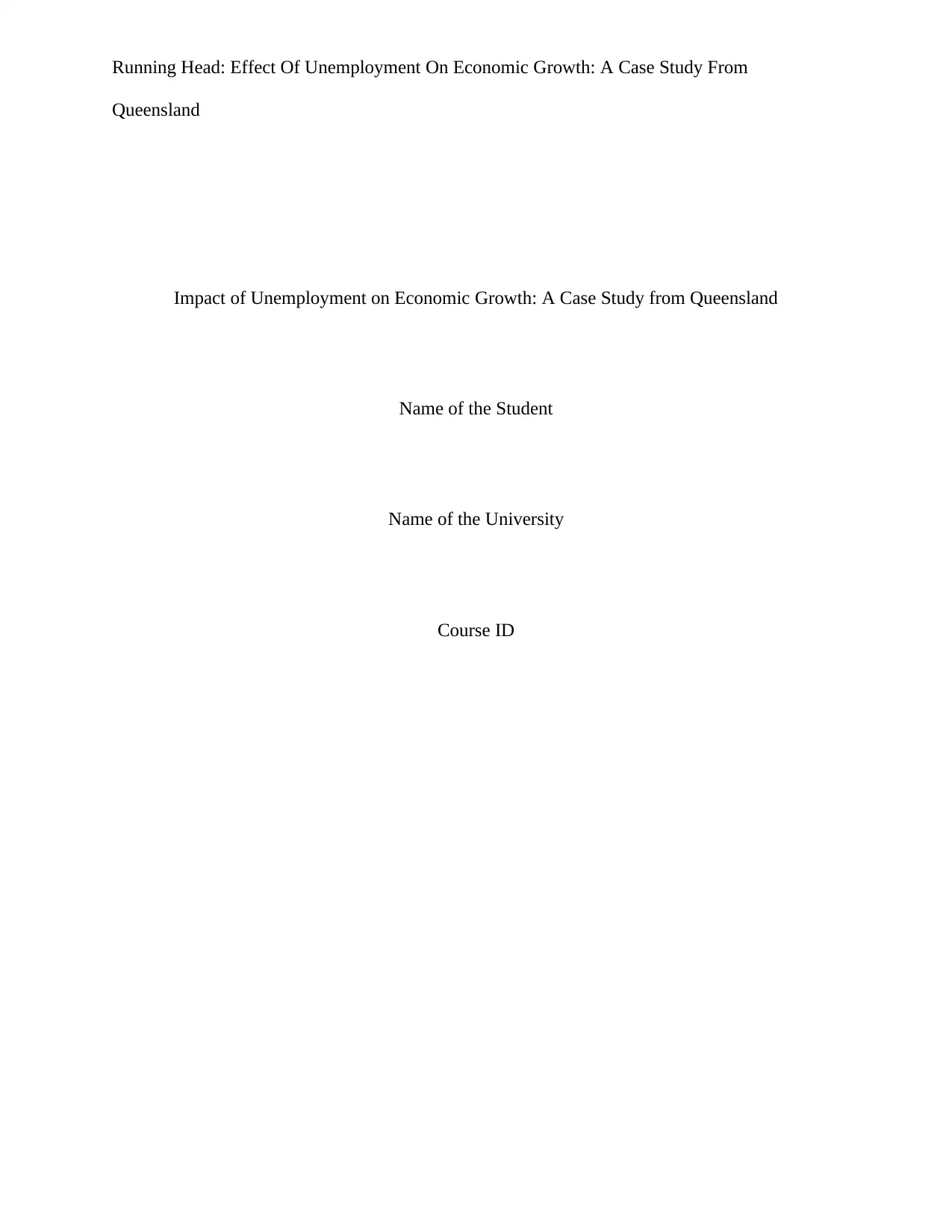
Running Head: Effect Of Unemployment On Economic Growth: A Case Study From
Queensland
Impact of Unemployment on Economic Growth: A Case Study from Queensland
Name of the Student
Name of the University
Course ID
Queensland
Impact of Unemployment on Economic Growth: A Case Study from Queensland
Name of the Student
Name of the University
Course ID
Secure Best Marks with AI Grader
Need help grading? Try our AI Grader for instant feedback on your assignments.
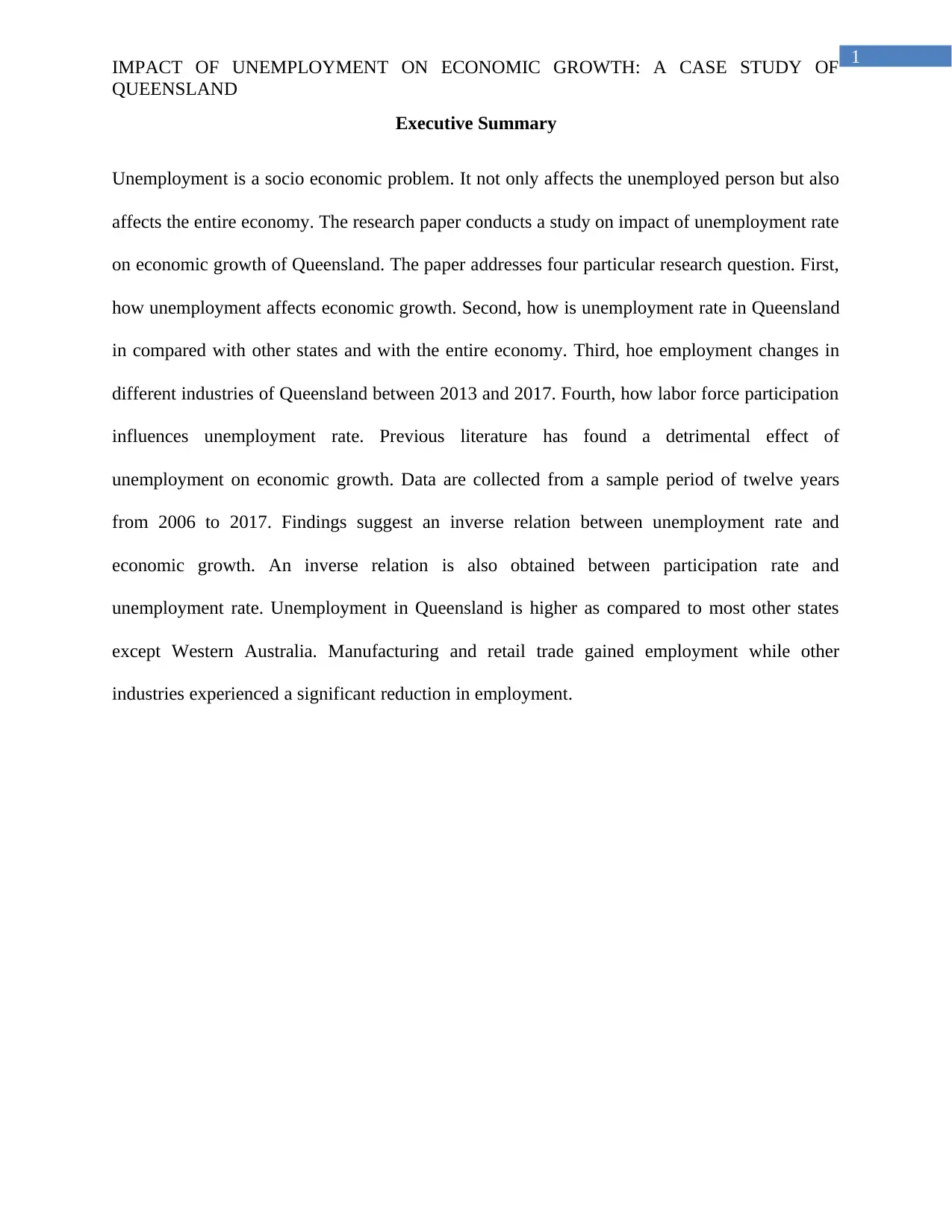
1
IMPACT OF UNEMPLOYMENT ON ECONOMIC GROWTH: A CASE STUDY OF
QUEENSLAND
Executive Summary
Unemployment is a socio economic problem. It not only affects the unemployed person but also
affects the entire economy. The research paper conducts a study on impact of unemployment rate
on economic growth of Queensland. The paper addresses four particular research question. First,
how unemployment affects economic growth. Second, how is unemployment rate in Queensland
in compared with other states and with the entire economy. Third, hoe employment changes in
different industries of Queensland between 2013 and 2017. Fourth, how labor force participation
influences unemployment rate. Previous literature has found a detrimental effect of
unemployment on economic growth. Data are collected from a sample period of twelve years
from 2006 to 2017. Findings suggest an inverse relation between unemployment rate and
economic growth. An inverse relation is also obtained between participation rate and
unemployment rate. Unemployment in Queensland is higher as compared to most other states
except Western Australia. Manufacturing and retail trade gained employment while other
industries experienced a significant reduction in employment.
IMPACT OF UNEMPLOYMENT ON ECONOMIC GROWTH: A CASE STUDY OF
QUEENSLAND
Executive Summary
Unemployment is a socio economic problem. It not only affects the unemployed person but also
affects the entire economy. The research paper conducts a study on impact of unemployment rate
on economic growth of Queensland. The paper addresses four particular research question. First,
how unemployment affects economic growth. Second, how is unemployment rate in Queensland
in compared with other states and with the entire economy. Third, hoe employment changes in
different industries of Queensland between 2013 and 2017. Fourth, how labor force participation
influences unemployment rate. Previous literature has found a detrimental effect of
unemployment on economic growth. Data are collected from a sample period of twelve years
from 2006 to 2017. Findings suggest an inverse relation between unemployment rate and
economic growth. An inverse relation is also obtained between participation rate and
unemployment rate. Unemployment in Queensland is higher as compared to most other states
except Western Australia. Manufacturing and retail trade gained employment while other
industries experienced a significant reduction in employment.
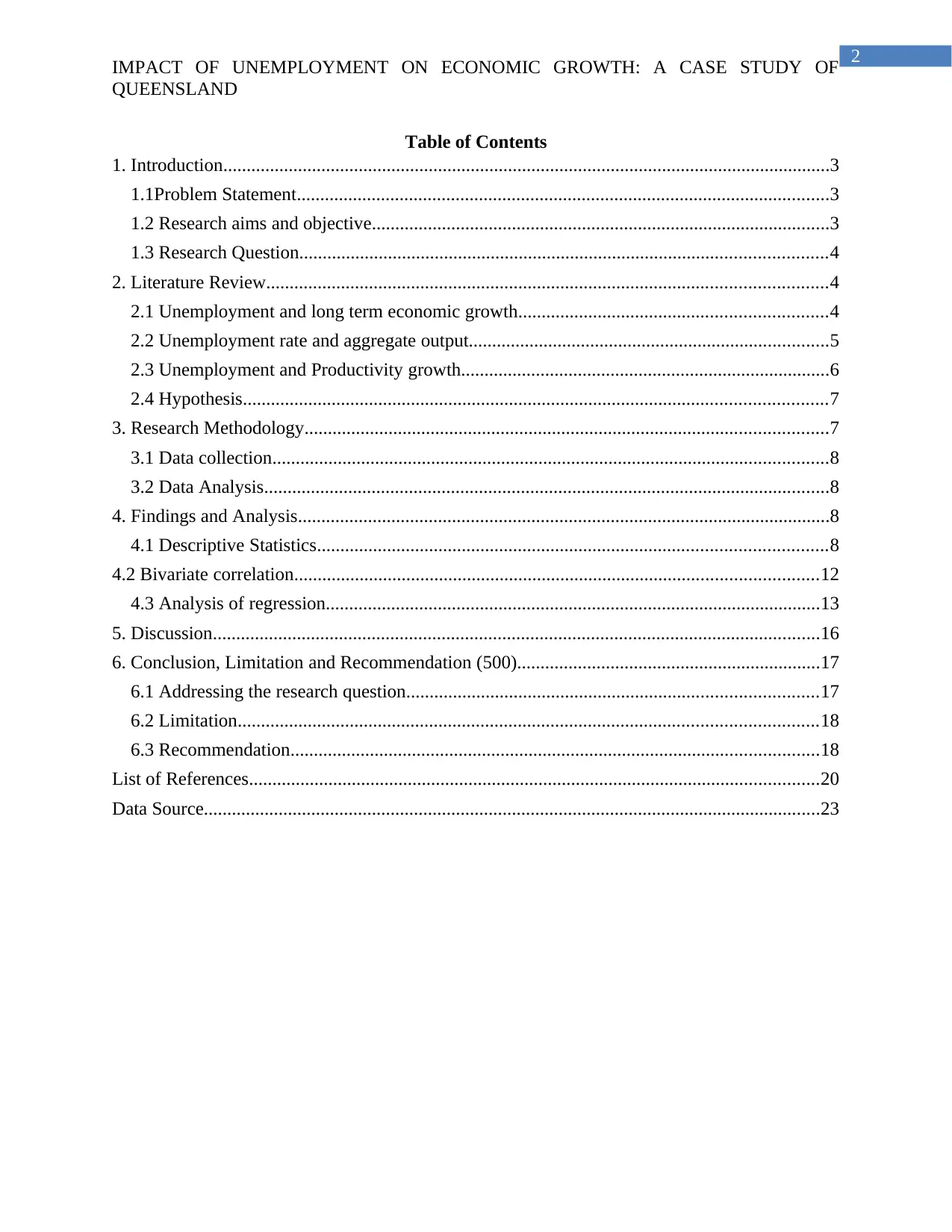
2
IMPACT OF UNEMPLOYMENT ON ECONOMIC GROWTH: A CASE STUDY OF
QUEENSLAND
Table of Contents
1. Introduction..................................................................................................................................3
1.1Problem Statement..................................................................................................................3
1.2 Research aims and objective..................................................................................................3
1.3 Research Question.................................................................................................................4
2. Literature Review........................................................................................................................4
2.1 Unemployment and long term economic growth..................................................................4
2.2 Unemployment rate and aggregate output.............................................................................5
2.3 Unemployment and Productivity growth...............................................................................6
2.4 Hypothesis.............................................................................................................................7
3. Research Methodology................................................................................................................7
3.1 Data collection.......................................................................................................................8
3.2 Data Analysis.........................................................................................................................8
4. Findings and Analysis..................................................................................................................8
4.1 Descriptive Statistics.............................................................................................................8
4.2 Bivariate correlation................................................................................................................12
4.3 Analysis of regression..........................................................................................................13
5. Discussion..................................................................................................................................16
6. Conclusion, Limitation and Recommendation (500).................................................................17
6.1 Addressing the research question........................................................................................17
6.2 Limitation............................................................................................................................18
6.3 Recommendation.................................................................................................................18
List of References..........................................................................................................................20
Data Source....................................................................................................................................23
IMPACT OF UNEMPLOYMENT ON ECONOMIC GROWTH: A CASE STUDY OF
QUEENSLAND
Table of Contents
1. Introduction..................................................................................................................................3
1.1Problem Statement..................................................................................................................3
1.2 Research aims and objective..................................................................................................3
1.3 Research Question.................................................................................................................4
2. Literature Review........................................................................................................................4
2.1 Unemployment and long term economic growth..................................................................4
2.2 Unemployment rate and aggregate output.............................................................................5
2.3 Unemployment and Productivity growth...............................................................................6
2.4 Hypothesis.............................................................................................................................7
3. Research Methodology................................................................................................................7
3.1 Data collection.......................................................................................................................8
3.2 Data Analysis.........................................................................................................................8
4. Findings and Analysis..................................................................................................................8
4.1 Descriptive Statistics.............................................................................................................8
4.2 Bivariate correlation................................................................................................................12
4.3 Analysis of regression..........................................................................................................13
5. Discussion..................................................................................................................................16
6. Conclusion, Limitation and Recommendation (500).................................................................17
6.1 Addressing the research question........................................................................................17
6.2 Limitation............................................................................................................................18
6.3 Recommendation.................................................................................................................18
List of References..........................................................................................................................20
Data Source....................................................................................................................................23
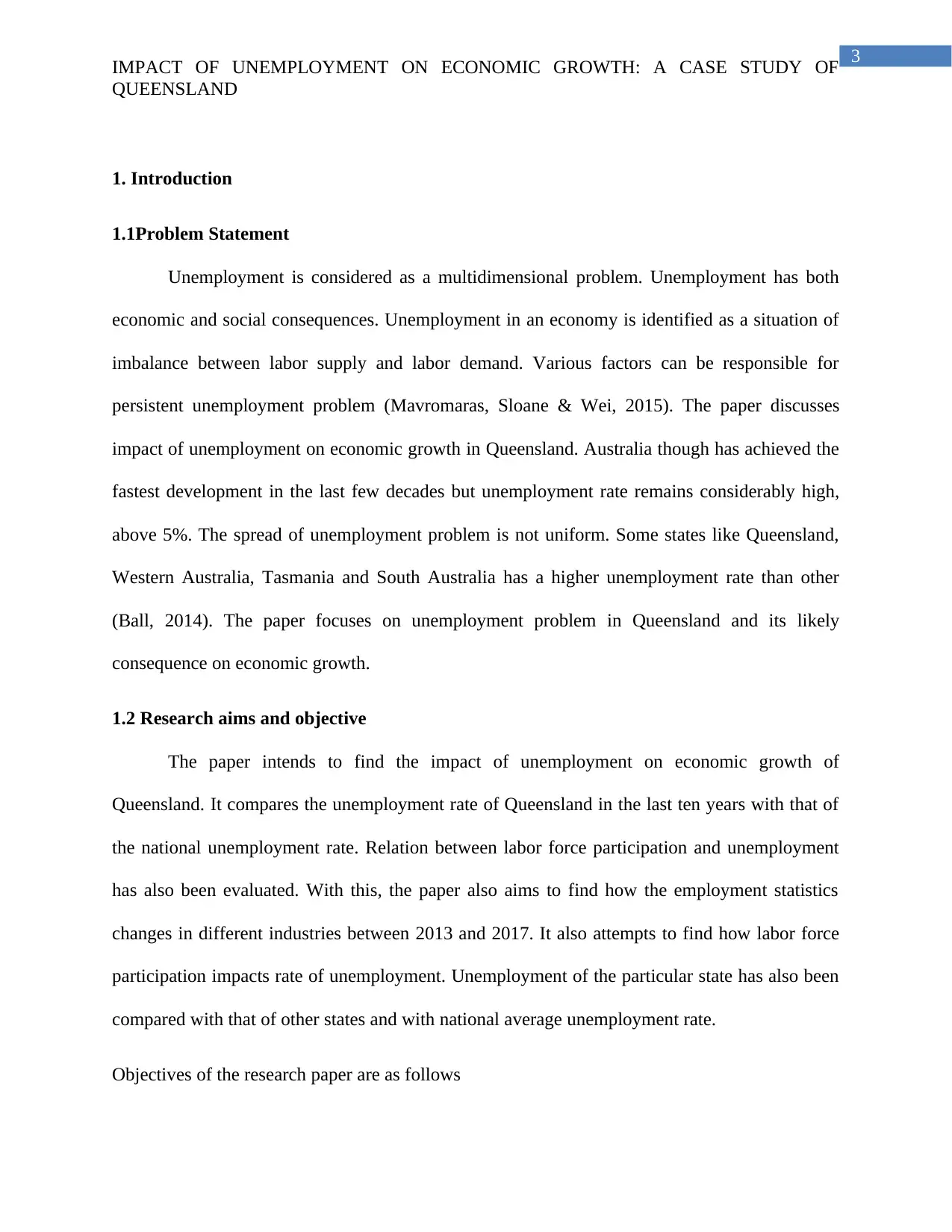
3
IMPACT OF UNEMPLOYMENT ON ECONOMIC GROWTH: A CASE STUDY OF
QUEENSLAND
1. Introduction
1.1Problem Statement
Unemployment is considered as a multidimensional problem. Unemployment has both
economic and social consequences. Unemployment in an economy is identified as a situation of
imbalance between labor supply and labor demand. Various factors can be responsible for
persistent unemployment problem (Mavromaras, Sloane & Wei, 2015). The paper discusses
impact of unemployment on economic growth in Queensland. Australia though has achieved the
fastest development in the last few decades but unemployment rate remains considerably high,
above 5%. The spread of unemployment problem is not uniform. Some states like Queensland,
Western Australia, Tasmania and South Australia has a higher unemployment rate than other
(Ball, 2014). The paper focuses on unemployment problem in Queensland and its likely
consequence on economic growth.
1.2 Research aims and objective
The paper intends to find the impact of unemployment on economic growth of
Queensland. It compares the unemployment rate of Queensland in the last ten years with that of
the national unemployment rate. Relation between labor force participation and unemployment
has also been evaluated. With this, the paper also aims to find how the employment statistics
changes in different industries between 2013 and 2017. It also attempts to find how labor force
participation impacts rate of unemployment. Unemployment of the particular state has also been
compared with that of other states and with national average unemployment rate.
Objectives of the research paper are as follows
IMPACT OF UNEMPLOYMENT ON ECONOMIC GROWTH: A CASE STUDY OF
QUEENSLAND
1. Introduction
1.1Problem Statement
Unemployment is considered as a multidimensional problem. Unemployment has both
economic and social consequences. Unemployment in an economy is identified as a situation of
imbalance between labor supply and labor demand. Various factors can be responsible for
persistent unemployment problem (Mavromaras, Sloane & Wei, 2015). The paper discusses
impact of unemployment on economic growth in Queensland. Australia though has achieved the
fastest development in the last few decades but unemployment rate remains considerably high,
above 5%. The spread of unemployment problem is not uniform. Some states like Queensland,
Western Australia, Tasmania and South Australia has a higher unemployment rate than other
(Ball, 2014). The paper focuses on unemployment problem in Queensland and its likely
consequence on economic growth.
1.2 Research aims and objective
The paper intends to find the impact of unemployment on economic growth of
Queensland. It compares the unemployment rate of Queensland in the last ten years with that of
the national unemployment rate. Relation between labor force participation and unemployment
has also been evaluated. With this, the paper also aims to find how the employment statistics
changes in different industries between 2013 and 2017. It also attempts to find how labor force
participation impacts rate of unemployment. Unemployment of the particular state has also been
compared with that of other states and with national average unemployment rate.
Objectives of the research paper are as follows
Secure Best Marks with AI Grader
Need help grading? Try our AI Grader for instant feedback on your assignments.
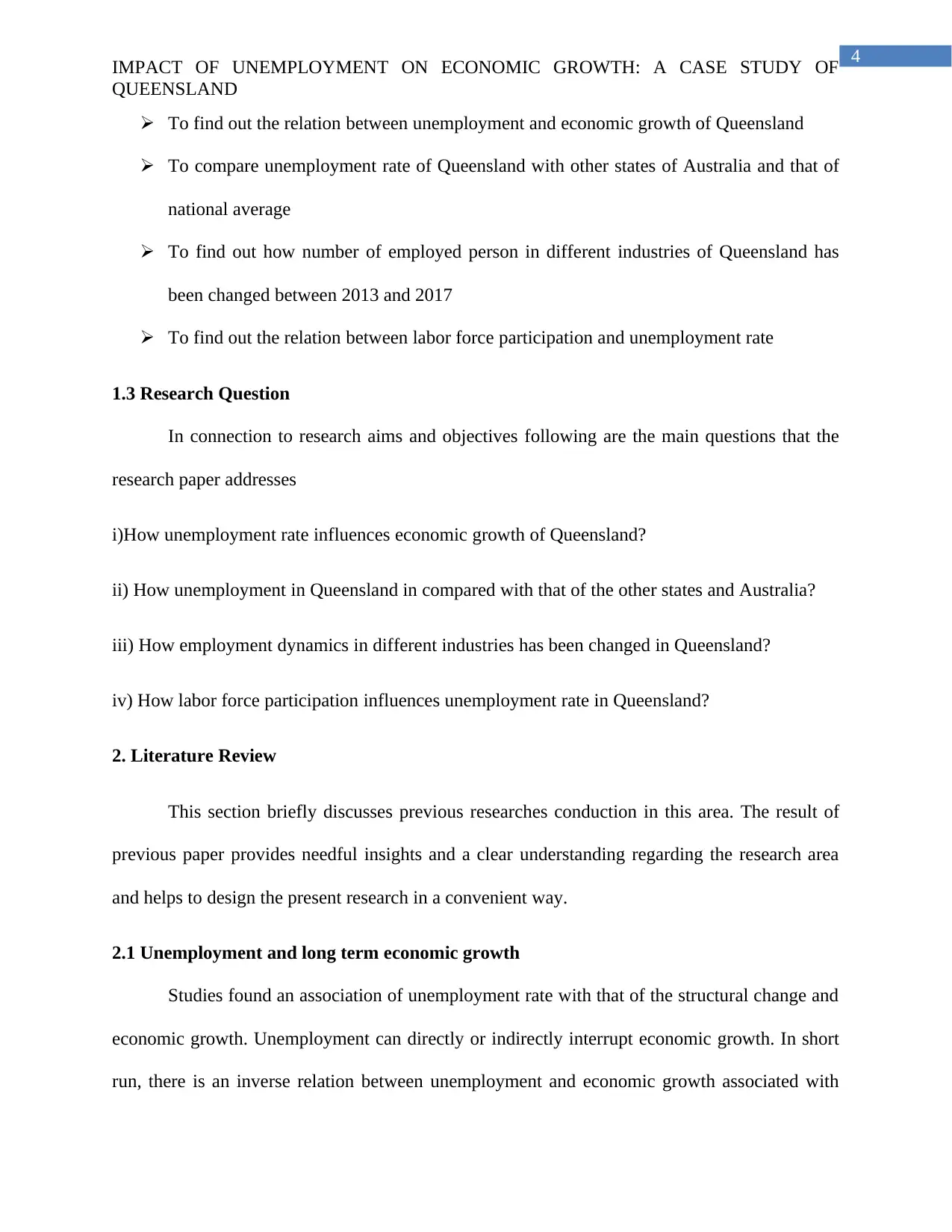
4
IMPACT OF UNEMPLOYMENT ON ECONOMIC GROWTH: A CASE STUDY OF
QUEENSLAND
To find out the relation between unemployment and economic growth of Queensland
To compare unemployment rate of Queensland with other states of Australia and that of
national average
To find out how number of employed person in different industries of Queensland has
been changed between 2013 and 2017
To find out the relation between labor force participation and unemployment rate
1.3 Research Question
In connection to research aims and objectives following are the main questions that the
research paper addresses
i)How unemployment rate influences economic growth of Queensland?
ii) How unemployment in Queensland in compared with that of the other states and Australia?
iii) How employment dynamics in different industries has been changed in Queensland?
iv) How labor force participation influences unemployment rate in Queensland?
2. Literature Review
This section briefly discusses previous researches conduction in this area. The result of
previous paper provides needful insights and a clear understanding regarding the research area
and helps to design the present research in a convenient way.
2.1 Unemployment and long term economic growth
Studies found an association of unemployment rate with that of the structural change and
economic growth. Unemployment can directly or indirectly interrupt economic growth. In short
run, there is an inverse relation between unemployment and economic growth associated with
IMPACT OF UNEMPLOYMENT ON ECONOMIC GROWTH: A CASE STUDY OF
QUEENSLAND
To find out the relation between unemployment and economic growth of Queensland
To compare unemployment rate of Queensland with other states of Australia and that of
national average
To find out how number of employed person in different industries of Queensland has
been changed between 2013 and 2017
To find out the relation between labor force participation and unemployment rate
1.3 Research Question
In connection to research aims and objectives following are the main questions that the
research paper addresses
i)How unemployment rate influences economic growth of Queensland?
ii) How unemployment in Queensland in compared with that of the other states and Australia?
iii) How employment dynamics in different industries has been changed in Queensland?
iv) How labor force participation influences unemployment rate in Queensland?
2. Literature Review
This section briefly discusses previous researches conduction in this area. The result of
previous paper provides needful insights and a clear understanding regarding the research area
and helps to design the present research in a convenient way.
2.1 Unemployment and long term economic growth
Studies found an association of unemployment rate with that of the structural change and
economic growth. Unemployment can directly or indirectly interrupt economic growth. In short
run, there is an inverse relation between unemployment and economic growth associated with
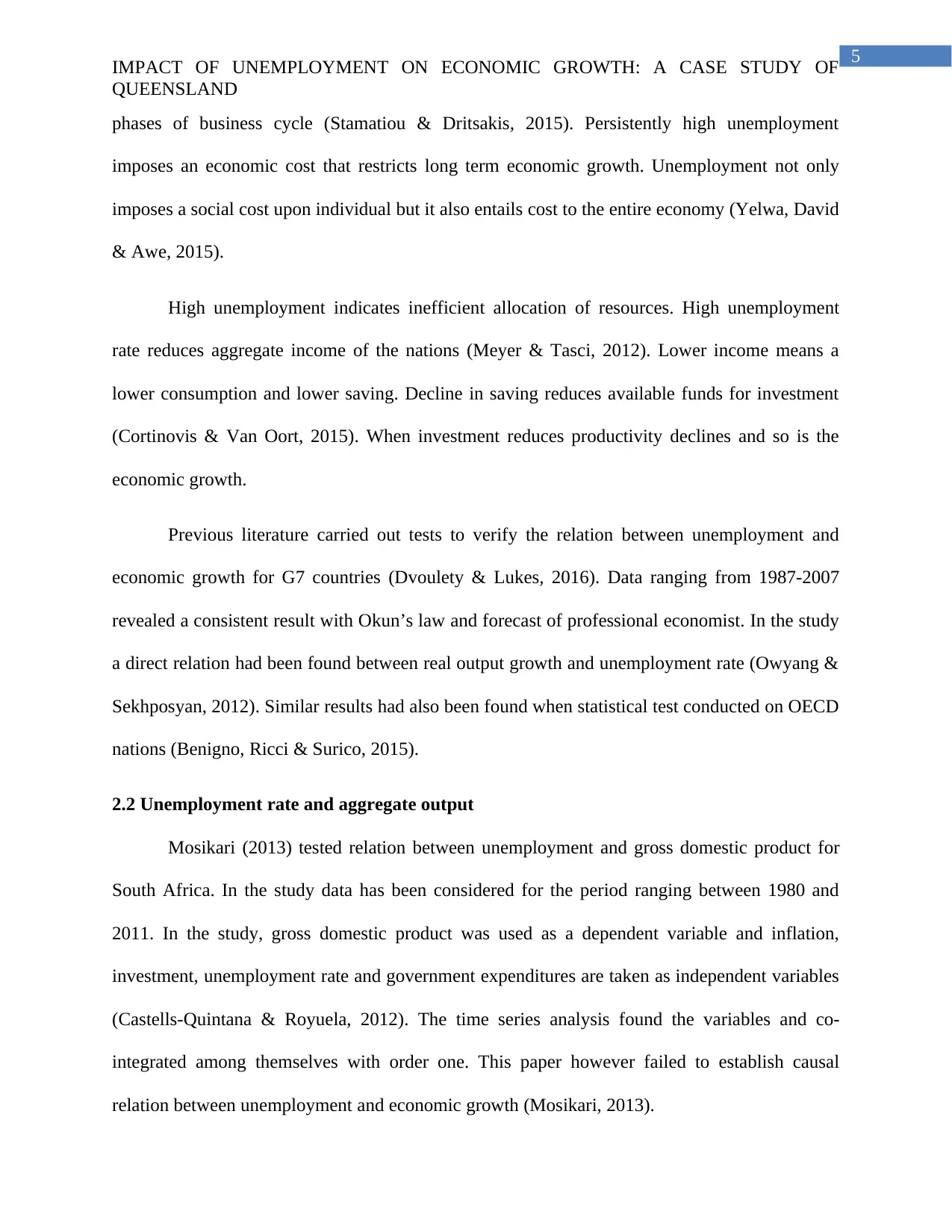
5
IMPACT OF UNEMPLOYMENT ON ECONOMIC GROWTH: A CASE STUDY OF
QUEENSLAND
phases of business cycle (Stamatiou & Dritsakis, 2015). Persistently high unemployment
imposes an economic cost that restricts long term economic growth. Unemployment not only
imposes a social cost upon individual but it also entails cost to the entire economy (Yelwa, David
& Awe, 2015).
High unemployment indicates inefficient allocation of resources. High unemployment
rate reduces aggregate income of the nations (Meyer & Tasci, 2012). Lower income means a
lower consumption and lower saving. Decline in saving reduces available funds for investment
(Cortinovis & Van Oort, 2015). When investment reduces productivity declines and so is the
economic growth.
Previous literature carried out tests to verify the relation between unemployment and
economic growth for G7 countries (Dvoulety & Lukes, 2016). Data ranging from 1987-2007
revealed a consistent result with Okun’s law and forecast of professional economist. In the study
a direct relation had been found between real output growth and unemployment rate (Owyang &
Sekhposyan, 2012). Similar results had also been found when statistical test conducted on OECD
nations (Benigno, Ricci & Surico, 2015).
2.2 Unemployment rate and aggregate output
Mosikari (2013) tested relation between unemployment and gross domestic product for
South Africa. In the study data has been considered for the period ranging between 1980 and
2011. In the study, gross domestic product was used as a dependent variable and inflation,
investment, unemployment rate and government expenditures are taken as independent variables
(Castells-Quintana & Royuela, 2012). The time series analysis found the variables and co-
integrated among themselves with order one. This paper however failed to establish causal
relation between unemployment and economic growth (Mosikari, 2013).
IMPACT OF UNEMPLOYMENT ON ECONOMIC GROWTH: A CASE STUDY OF
QUEENSLAND
phases of business cycle (Stamatiou & Dritsakis, 2015). Persistently high unemployment
imposes an economic cost that restricts long term economic growth. Unemployment not only
imposes a social cost upon individual but it also entails cost to the entire economy (Yelwa, David
& Awe, 2015).
High unemployment indicates inefficient allocation of resources. High unemployment
rate reduces aggregate income of the nations (Meyer & Tasci, 2012). Lower income means a
lower consumption and lower saving. Decline in saving reduces available funds for investment
(Cortinovis & Van Oort, 2015). When investment reduces productivity declines and so is the
economic growth.
Previous literature carried out tests to verify the relation between unemployment and
economic growth for G7 countries (Dvoulety & Lukes, 2016). Data ranging from 1987-2007
revealed a consistent result with Okun’s law and forecast of professional economist. In the study
a direct relation had been found between real output growth and unemployment rate (Owyang &
Sekhposyan, 2012). Similar results had also been found when statistical test conducted on OECD
nations (Benigno, Ricci & Surico, 2015).
2.2 Unemployment rate and aggregate output
Mosikari (2013) tested relation between unemployment and gross domestic product for
South Africa. In the study data has been considered for the period ranging between 1980 and
2011. In the study, gross domestic product was used as a dependent variable and inflation,
investment, unemployment rate and government expenditures are taken as independent variables
(Castells-Quintana & Royuela, 2012). The time series analysis found the variables and co-
integrated among themselves with order one. This paper however failed to establish causal
relation between unemployment and economic growth (Mosikari, 2013).
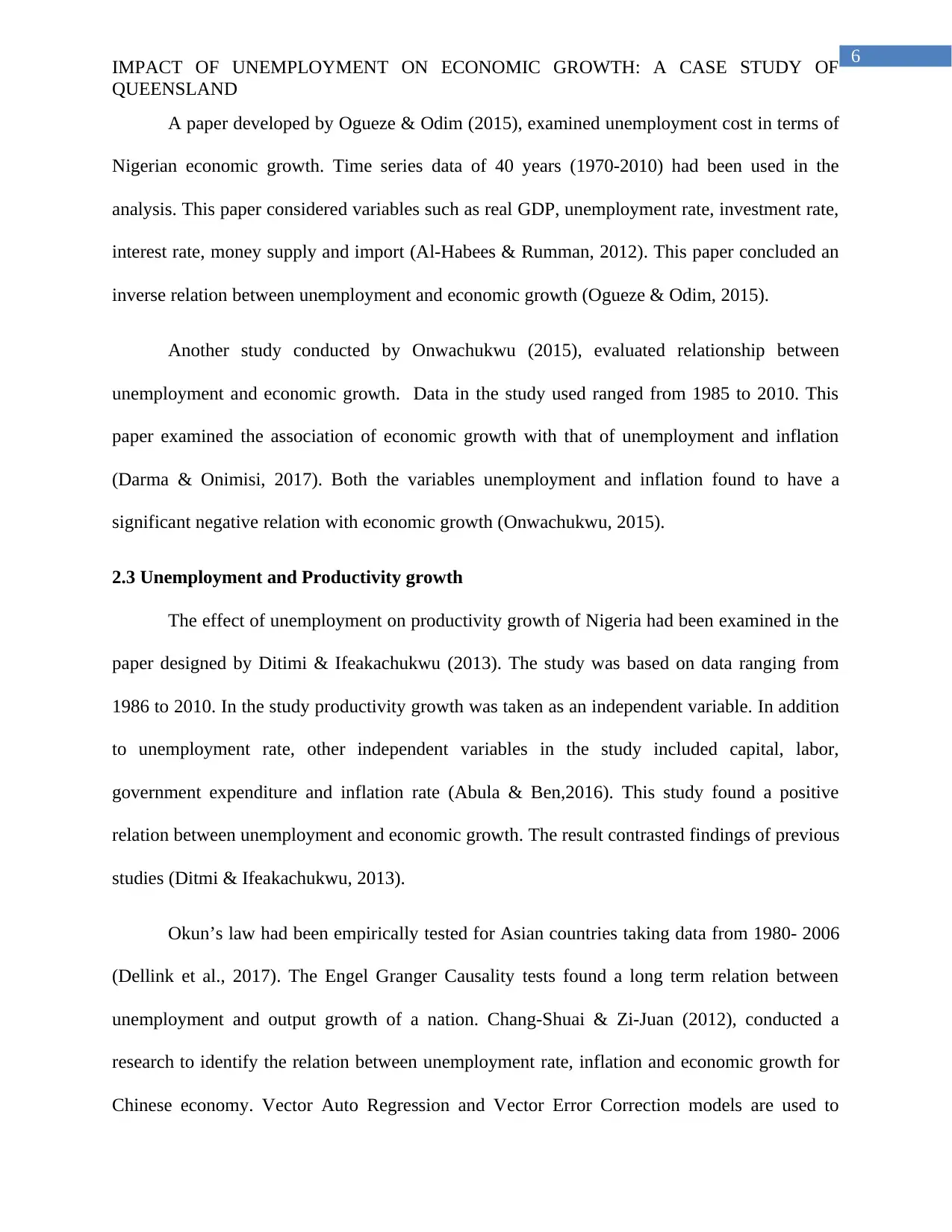
6
IMPACT OF UNEMPLOYMENT ON ECONOMIC GROWTH: A CASE STUDY OF
QUEENSLAND
A paper developed by Ogueze & Odim (2015), examined unemployment cost in terms of
Nigerian economic growth. Time series data of 40 years (1970-2010) had been used in the
analysis. This paper considered variables such as real GDP, unemployment rate, investment rate,
interest rate, money supply and import (Al-Habees & Rumman, 2012). This paper concluded an
inverse relation between unemployment and economic growth (Ogueze & Odim, 2015).
Another study conducted by Onwachukwu (2015), evaluated relationship between
unemployment and economic growth. Data in the study used ranged from 1985 to 2010. This
paper examined the association of economic growth with that of unemployment and inflation
(Darma & Onimisi, 2017). Both the variables unemployment and inflation found to have a
significant negative relation with economic growth (Onwachukwu, 2015).
2.3 Unemployment and Productivity growth
The effect of unemployment on productivity growth of Nigeria had been examined in the
paper designed by Ditimi & Ifeakachukwu (2013). The study was based on data ranging from
1986 to 2010. In the study productivity growth was taken as an independent variable. In addition
to unemployment rate, other independent variables in the study included capital, labor,
government expenditure and inflation rate (Abula & Ben,2016). This study found a positive
relation between unemployment and economic growth. The result contrasted findings of previous
studies (Ditmi & Ifeakachukwu, 2013).
Okun’s law had been empirically tested for Asian countries taking data from 1980- 2006
(Dellink et al., 2017). The Engel Granger Causality tests found a long term relation between
unemployment and output growth of a nation. Chang-Shuai & Zi-Juan (2012), conducted a
research to identify the relation between unemployment rate, inflation and economic growth for
Chinese economy. Vector Auto Regression and Vector Error Correction models are used to
IMPACT OF UNEMPLOYMENT ON ECONOMIC GROWTH: A CASE STUDY OF
QUEENSLAND
A paper developed by Ogueze & Odim (2015), examined unemployment cost in terms of
Nigerian economic growth. Time series data of 40 years (1970-2010) had been used in the
analysis. This paper considered variables such as real GDP, unemployment rate, investment rate,
interest rate, money supply and import (Al-Habees & Rumman, 2012). This paper concluded an
inverse relation between unemployment and economic growth (Ogueze & Odim, 2015).
Another study conducted by Onwachukwu (2015), evaluated relationship between
unemployment and economic growth. Data in the study used ranged from 1985 to 2010. This
paper examined the association of economic growth with that of unemployment and inflation
(Darma & Onimisi, 2017). Both the variables unemployment and inflation found to have a
significant negative relation with economic growth (Onwachukwu, 2015).
2.3 Unemployment and Productivity growth
The effect of unemployment on productivity growth of Nigeria had been examined in the
paper designed by Ditimi & Ifeakachukwu (2013). The study was based on data ranging from
1986 to 2010. In the study productivity growth was taken as an independent variable. In addition
to unemployment rate, other independent variables in the study included capital, labor,
government expenditure and inflation rate (Abula & Ben,2016). This study found a positive
relation between unemployment and economic growth. The result contrasted findings of previous
studies (Ditmi & Ifeakachukwu, 2013).
Okun’s law had been empirically tested for Asian countries taking data from 1980- 2006
(Dellink et al., 2017). The Engel Granger Causality tests found a long term relation between
unemployment and output growth of a nation. Chang-Shuai & Zi-Juan (2012), conducted a
research to identify the relation between unemployment rate, inflation and economic growth for
Chinese economy. Vector Auto Regression and Vector Error Correction models are used to
Paraphrase This Document
Need a fresh take? Get an instant paraphrase of this document with our AI Paraphraser
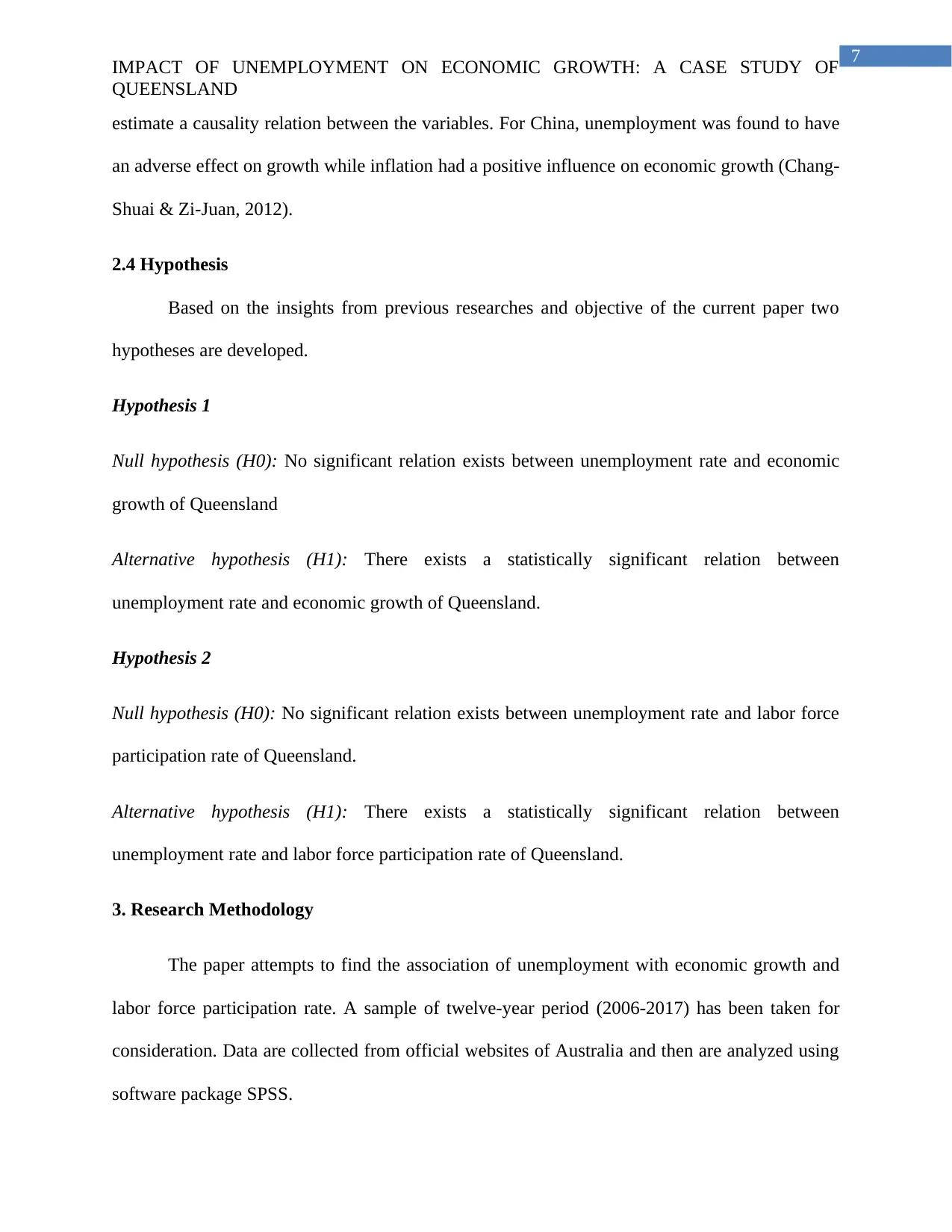
7
IMPACT OF UNEMPLOYMENT ON ECONOMIC GROWTH: A CASE STUDY OF
QUEENSLAND
estimate a causality relation between the variables. For China, unemployment was found to have
an adverse effect on growth while inflation had a positive influence on economic growth (Chang-
Shuai & Zi-Juan, 2012).
2.4 Hypothesis
Based on the insights from previous researches and objective of the current paper two
hypotheses are developed.
Hypothesis 1
Null hypothesis (H0): No significant relation exists between unemployment rate and economic
growth of Queensland
Alternative hypothesis (H1): There exists a statistically significant relation between
unemployment rate and economic growth of Queensland.
Hypothesis 2
Null hypothesis (H0): No significant relation exists between unemployment rate and labor force
participation rate of Queensland.
Alternative hypothesis (H1): There exists a statistically significant relation between
unemployment rate and labor force participation rate of Queensland.
3. Research Methodology
The paper attempts to find the association of unemployment with economic growth and
labor force participation rate. A sample of twelve-year period (2006-2017) has been taken for
consideration. Data are collected from official websites of Australia and then are analyzed using
software package SPSS.
IMPACT OF UNEMPLOYMENT ON ECONOMIC GROWTH: A CASE STUDY OF
QUEENSLAND
estimate a causality relation between the variables. For China, unemployment was found to have
an adverse effect on growth while inflation had a positive influence on economic growth (Chang-
Shuai & Zi-Juan, 2012).
2.4 Hypothesis
Based on the insights from previous researches and objective of the current paper two
hypotheses are developed.
Hypothesis 1
Null hypothesis (H0): No significant relation exists between unemployment rate and economic
growth of Queensland
Alternative hypothesis (H1): There exists a statistically significant relation between
unemployment rate and economic growth of Queensland.
Hypothesis 2
Null hypothesis (H0): No significant relation exists between unemployment rate and labor force
participation rate of Queensland.
Alternative hypothesis (H1): There exists a statistically significant relation between
unemployment rate and labor force participation rate of Queensland.
3. Research Methodology
The paper attempts to find the association of unemployment with economic growth and
labor force participation rate. A sample of twelve-year period (2006-2017) has been taken for
consideration. Data are collected from official websites of Australia and then are analyzed using
software package SPSS.
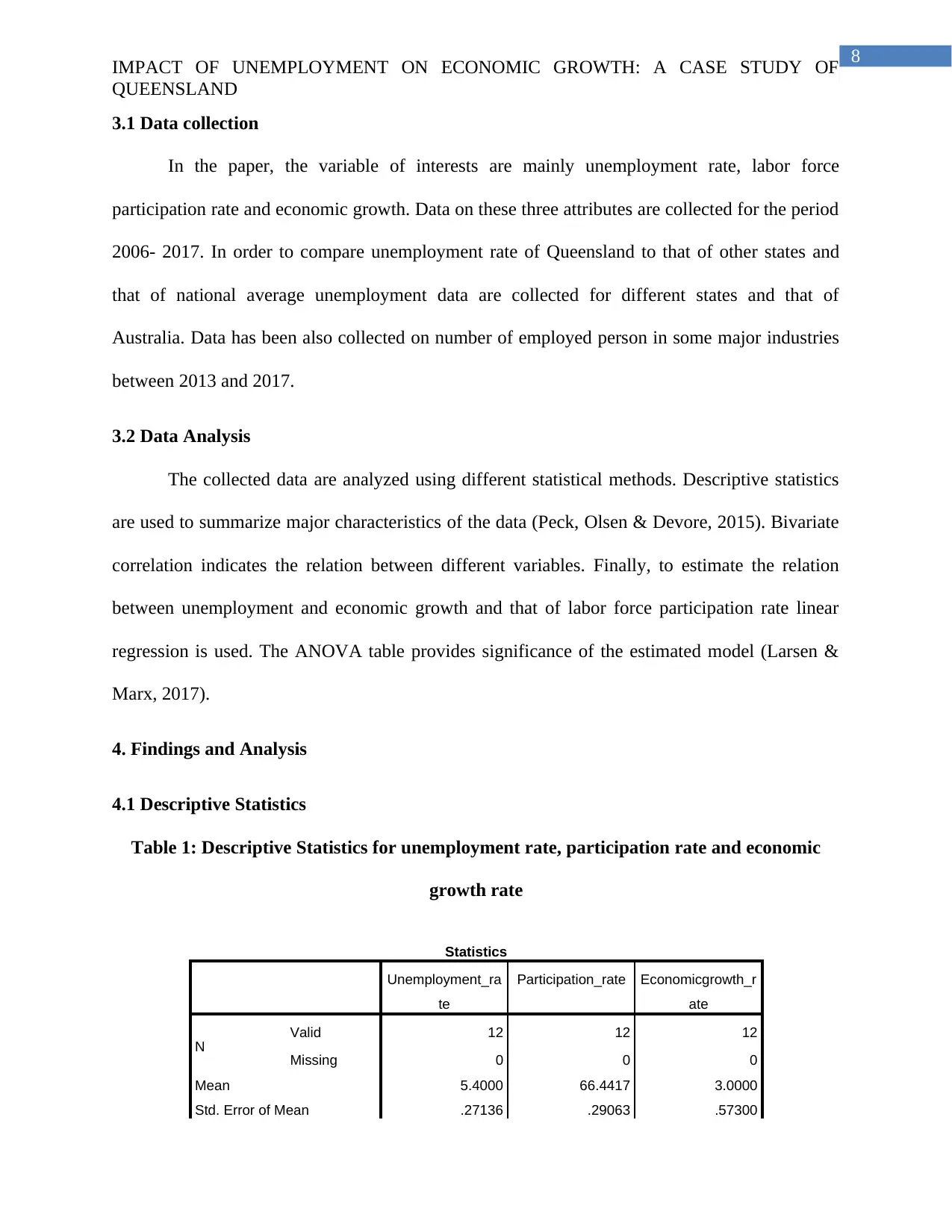
8
IMPACT OF UNEMPLOYMENT ON ECONOMIC GROWTH: A CASE STUDY OF
QUEENSLAND
3.1 Data collection
In the paper, the variable of interests are mainly unemployment rate, labor force
participation rate and economic growth. Data on these three attributes are collected for the period
2006- 2017. In order to compare unemployment rate of Queensland to that of other states and
that of national average unemployment data are collected for different states and that of
Australia. Data has been also collected on number of employed person in some major industries
between 2013 and 2017.
3.2 Data Analysis
The collected data are analyzed using different statistical methods. Descriptive statistics
are used to summarize major characteristics of the data (Peck, Olsen & Devore, 2015). Bivariate
correlation indicates the relation between different variables. Finally, to estimate the relation
between unemployment and economic growth and that of labor force participation rate linear
regression is used. The ANOVA table provides significance of the estimated model (Larsen &
Marx, 2017).
4. Findings and Analysis
4.1 Descriptive Statistics
Table 1: Descriptive Statistics for unemployment rate, participation rate and economic
growth rate
Statistics
Unemployment_ra
te
Participation_rate Economicgrowth_r
ate
N Valid 12 12 12
Missing 0 0 0
Mean 5.4000 66.4417 3.0000
Std. Error of Mean .27136 .29063 .57300
IMPACT OF UNEMPLOYMENT ON ECONOMIC GROWTH: A CASE STUDY OF
QUEENSLAND
3.1 Data collection
In the paper, the variable of interests are mainly unemployment rate, labor force
participation rate and economic growth. Data on these three attributes are collected for the period
2006- 2017. In order to compare unemployment rate of Queensland to that of other states and
that of national average unemployment data are collected for different states and that of
Australia. Data has been also collected on number of employed person in some major industries
between 2013 and 2017.
3.2 Data Analysis
The collected data are analyzed using different statistical methods. Descriptive statistics
are used to summarize major characteristics of the data (Peck, Olsen & Devore, 2015). Bivariate
correlation indicates the relation between different variables. Finally, to estimate the relation
between unemployment and economic growth and that of labor force participation rate linear
regression is used. The ANOVA table provides significance of the estimated model (Larsen &
Marx, 2017).
4. Findings and Analysis
4.1 Descriptive Statistics
Table 1: Descriptive Statistics for unemployment rate, participation rate and economic
growth rate
Statistics
Unemployment_ra
te
Participation_rate Economicgrowth_r
ate
N Valid 12 12 12
Missing 0 0 0
Mean 5.4000 66.4417 3.0000
Std. Error of Mean .27136 .29063 .57300
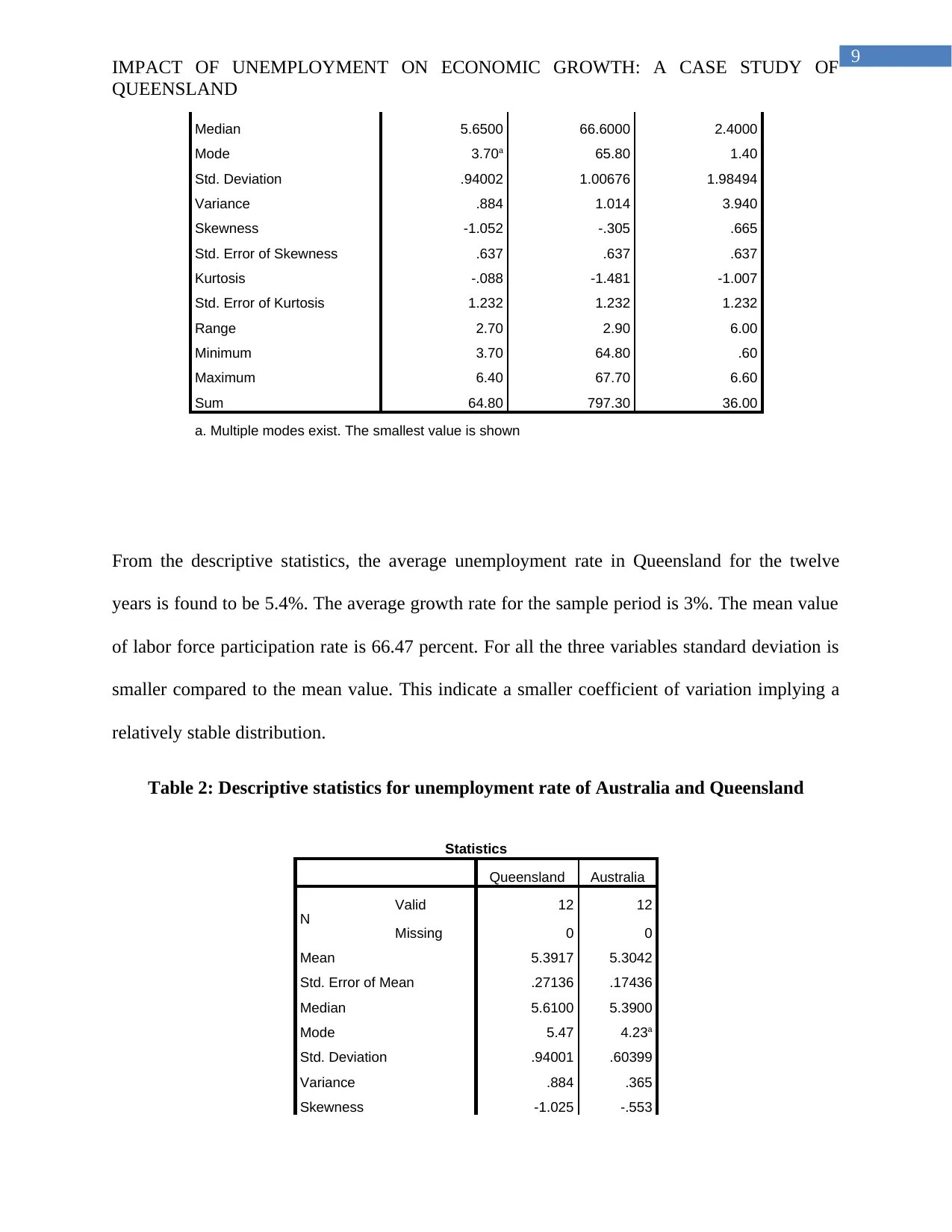
9
IMPACT OF UNEMPLOYMENT ON ECONOMIC GROWTH: A CASE STUDY OF
QUEENSLAND
Median 5.6500 66.6000 2.4000
Mode 3.70a 65.80 1.40
Std. Deviation .94002 1.00676 1.98494
Variance .884 1.014 3.940
Skewness -1.052 -.305 .665
Std. Error of Skewness .637 .637 .637
Kurtosis -.088 -1.481 -1.007
Std. Error of Kurtosis 1.232 1.232 1.232
Range 2.70 2.90 6.00
Minimum 3.70 64.80 .60
Maximum 6.40 67.70 6.60
Sum 64.80 797.30 36.00
a. Multiple modes exist. The smallest value is shown
From the descriptive statistics, the average unemployment rate in Queensland for the twelve
years is found to be 5.4%. The average growth rate for the sample period is 3%. The mean value
of labor force participation rate is 66.47 percent. For all the three variables standard deviation is
smaller compared to the mean value. This indicate a smaller coefficient of variation implying a
relatively stable distribution.
Table 2: Descriptive statistics for unemployment rate of Australia and Queensland
Statistics
Queensland Australia
N Valid 12 12
Missing 0 0
Mean 5.3917 5.3042
Std. Error of Mean .27136 .17436
Median 5.6100 5.3900
Mode 5.47 4.23a
Std. Deviation .94001 .60399
Variance .884 .365
Skewness -1.025 -.553
IMPACT OF UNEMPLOYMENT ON ECONOMIC GROWTH: A CASE STUDY OF
QUEENSLAND
Median 5.6500 66.6000 2.4000
Mode 3.70a 65.80 1.40
Std. Deviation .94002 1.00676 1.98494
Variance .884 1.014 3.940
Skewness -1.052 -.305 .665
Std. Error of Skewness .637 .637 .637
Kurtosis -.088 -1.481 -1.007
Std. Error of Kurtosis 1.232 1.232 1.232
Range 2.70 2.90 6.00
Minimum 3.70 64.80 .60
Maximum 6.40 67.70 6.60
Sum 64.80 797.30 36.00
a. Multiple modes exist. The smallest value is shown
From the descriptive statistics, the average unemployment rate in Queensland for the twelve
years is found to be 5.4%. The average growth rate for the sample period is 3%. The mean value
of labor force participation rate is 66.47 percent. For all the three variables standard deviation is
smaller compared to the mean value. This indicate a smaller coefficient of variation implying a
relatively stable distribution.
Table 2: Descriptive statistics for unemployment rate of Australia and Queensland
Statistics
Queensland Australia
N Valid 12 12
Missing 0 0
Mean 5.3917 5.3042
Std. Error of Mean .27136 .17436
Median 5.6100 5.3900
Mode 5.47 4.23a
Std. Deviation .94001 .60399
Variance .884 .365
Skewness -1.025 -.553
Secure Best Marks with AI Grader
Need help grading? Try our AI Grader for instant feedback on your assignments.
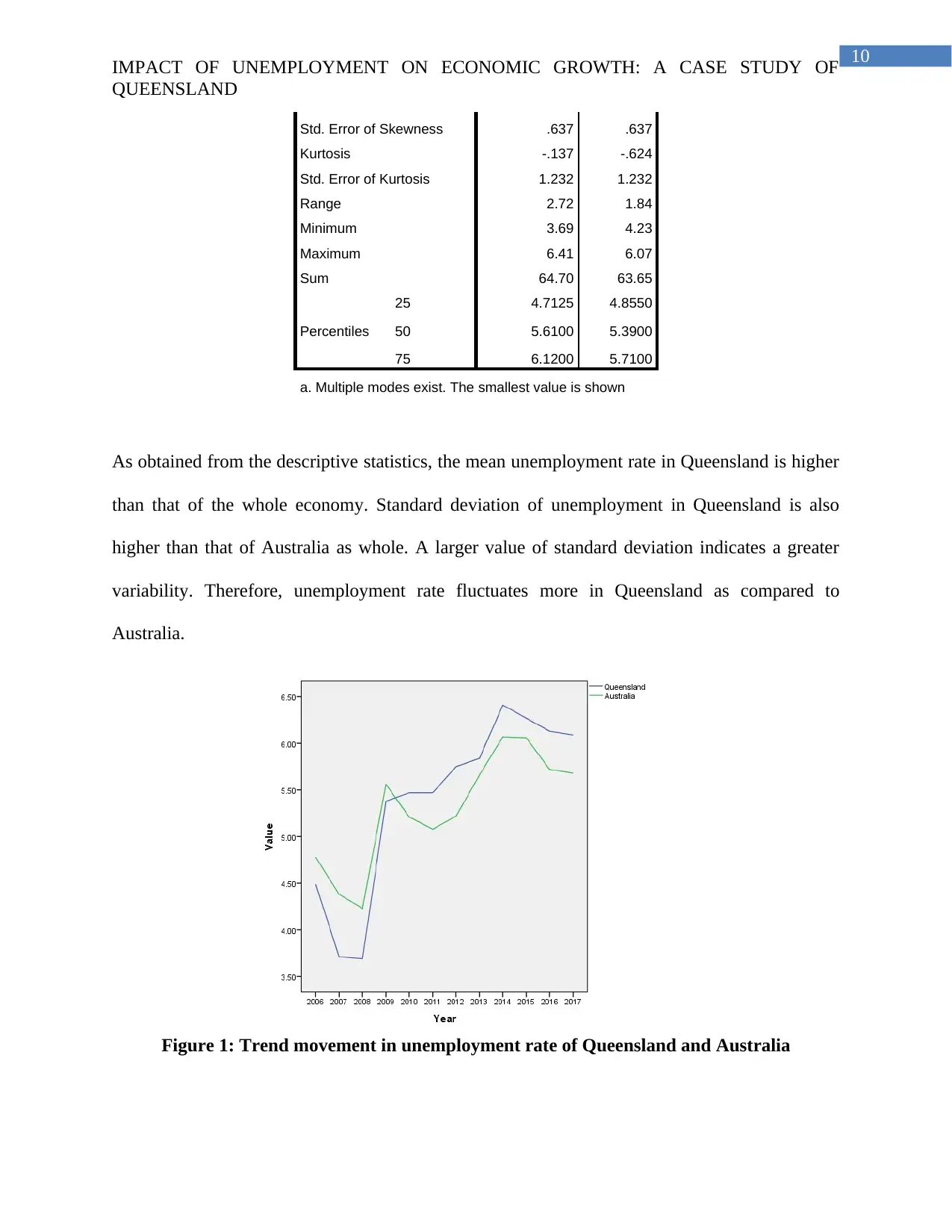
10
IMPACT OF UNEMPLOYMENT ON ECONOMIC GROWTH: A CASE STUDY OF
QUEENSLAND
Std. Error of Skewness .637 .637
Kurtosis -.137 -.624
Std. Error of Kurtosis 1.232 1.232
Range 2.72 1.84
Minimum 3.69 4.23
Maximum 6.41 6.07
Sum 64.70 63.65
Percentiles
25 4.7125 4.8550
50 5.6100 5.3900
75 6.1200 5.7100
a. Multiple modes exist. The smallest value is shown
As obtained from the descriptive statistics, the mean unemployment rate in Queensland is higher
than that of the whole economy. Standard deviation of unemployment in Queensland is also
higher than that of Australia as whole. A larger value of standard deviation indicates a greater
variability. Therefore, unemployment rate fluctuates more in Queensland as compared to
Australia.
Figure 1: Trend movement in unemployment rate of Queensland and Australia
IMPACT OF UNEMPLOYMENT ON ECONOMIC GROWTH: A CASE STUDY OF
QUEENSLAND
Std. Error of Skewness .637 .637
Kurtosis -.137 -.624
Std. Error of Kurtosis 1.232 1.232
Range 2.72 1.84
Minimum 3.69 4.23
Maximum 6.41 6.07
Sum 64.70 63.65
Percentiles
25 4.7125 4.8550
50 5.6100 5.3900
75 6.1200 5.7100
a. Multiple modes exist. The smallest value is shown
As obtained from the descriptive statistics, the mean unemployment rate in Queensland is higher
than that of the whole economy. Standard deviation of unemployment in Queensland is also
higher than that of Australia as whole. A larger value of standard deviation indicates a greater
variability. Therefore, unemployment rate fluctuates more in Queensland as compared to
Australia.
Figure 1: Trend movement in unemployment rate of Queensland and Australia
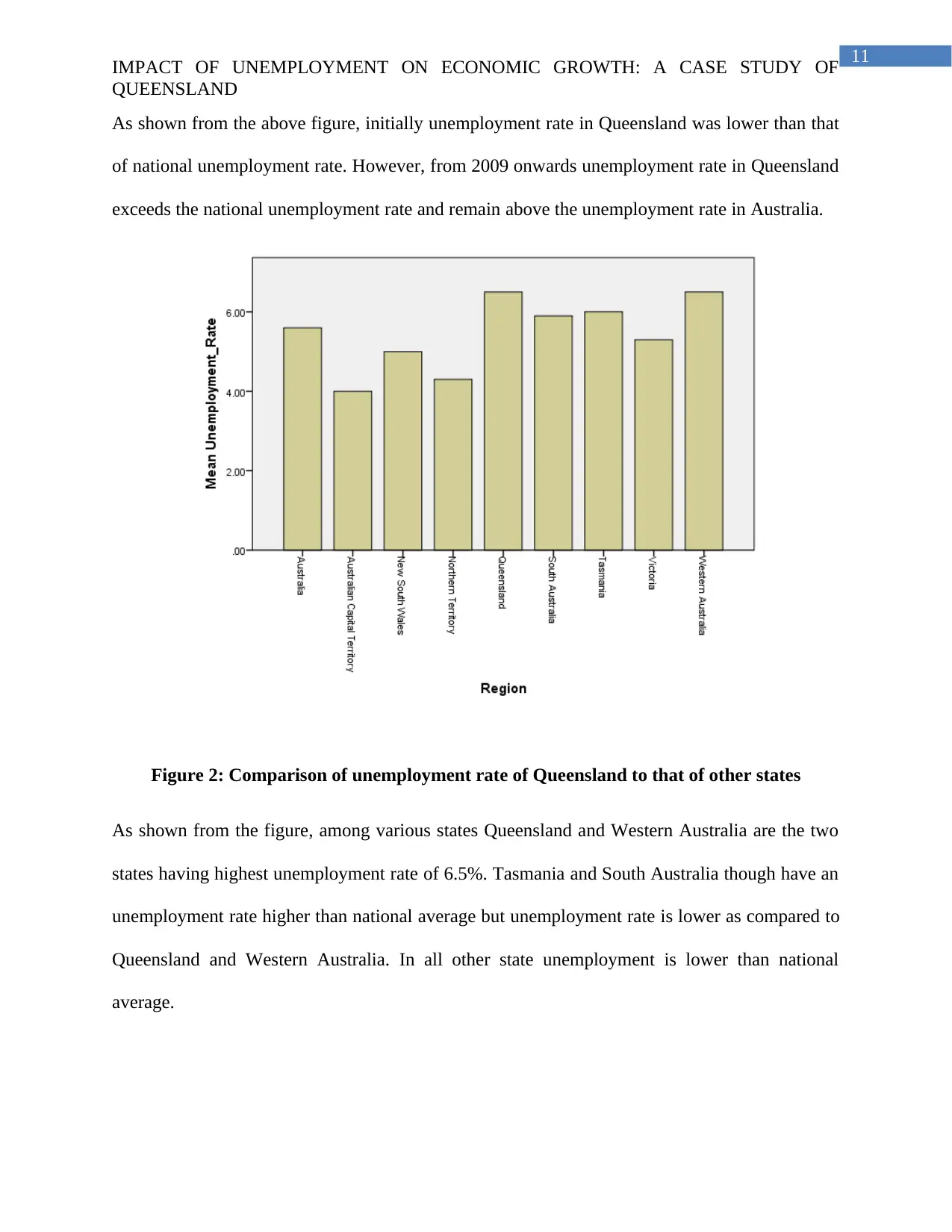
11
IMPACT OF UNEMPLOYMENT ON ECONOMIC GROWTH: A CASE STUDY OF
QUEENSLAND
As shown from the above figure, initially unemployment rate in Queensland was lower than that
of national unemployment rate. However, from 2009 onwards unemployment rate in Queensland
exceeds the national unemployment rate and remain above the unemployment rate in Australia.
Figure 2: Comparison of unemployment rate of Queensland to that of other states
As shown from the figure, among various states Queensland and Western Australia are the two
states having highest unemployment rate of 6.5%. Tasmania and South Australia though have an
unemployment rate higher than national average but unemployment rate is lower as compared to
Queensland and Western Australia. In all other state unemployment is lower than national
average.
IMPACT OF UNEMPLOYMENT ON ECONOMIC GROWTH: A CASE STUDY OF
QUEENSLAND
As shown from the above figure, initially unemployment rate in Queensland was lower than that
of national unemployment rate. However, from 2009 onwards unemployment rate in Queensland
exceeds the national unemployment rate and remain above the unemployment rate in Australia.
Figure 2: Comparison of unemployment rate of Queensland to that of other states
As shown from the figure, among various states Queensland and Western Australia are the two
states having highest unemployment rate of 6.5%. Tasmania and South Australia though have an
unemployment rate higher than national average but unemployment rate is lower as compared to
Queensland and Western Australia. In all other state unemployment is lower than national
average.
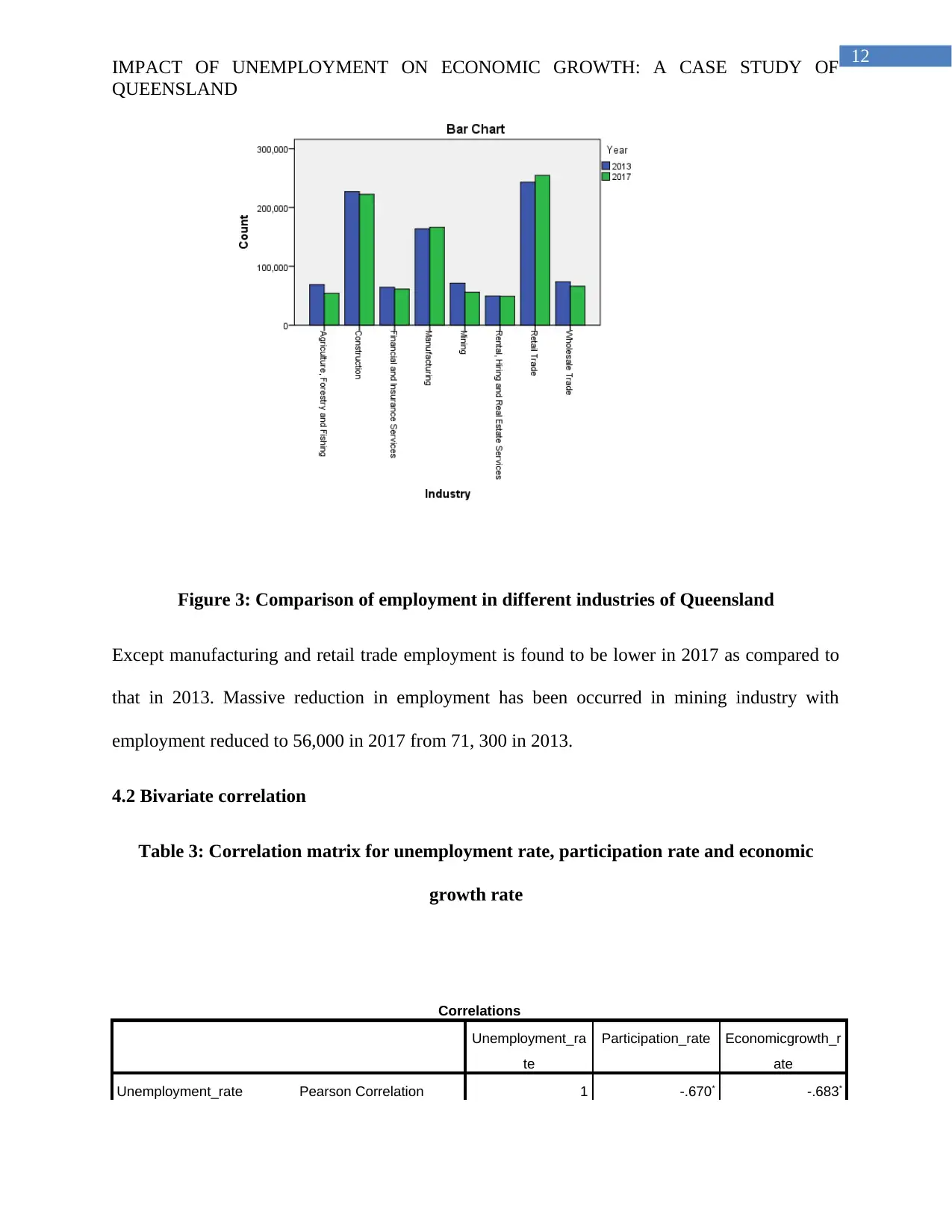
12
IMPACT OF UNEMPLOYMENT ON ECONOMIC GROWTH: A CASE STUDY OF
QUEENSLAND
Figure 3: Comparison of employment in different industries of Queensland
Except manufacturing and retail trade employment is found to be lower in 2017 as compared to
that in 2013. Massive reduction in employment has been occurred in mining industry with
employment reduced to 56,000 in 2017 from 71, 300 in 2013.
4.2 Bivariate correlation
Table 3: Correlation matrix for unemployment rate, participation rate and economic
growth rate
Correlations
Unemployment_ra
te
Participation_rate Economicgrowth_r
ate
Unemployment_rate Pearson Correlation 1 -.670* -.683*
IMPACT OF UNEMPLOYMENT ON ECONOMIC GROWTH: A CASE STUDY OF
QUEENSLAND
Figure 3: Comparison of employment in different industries of Queensland
Except manufacturing and retail trade employment is found to be lower in 2017 as compared to
that in 2013. Massive reduction in employment has been occurred in mining industry with
employment reduced to 56,000 in 2017 from 71, 300 in 2013.
4.2 Bivariate correlation
Table 3: Correlation matrix for unemployment rate, participation rate and economic
growth rate
Correlations
Unemployment_ra
te
Participation_rate Economicgrowth_r
ate
Unemployment_rate Pearson Correlation 1 -.670* -.683*
Paraphrase This Document
Need a fresh take? Get an instant paraphrase of this document with our AI Paraphraser
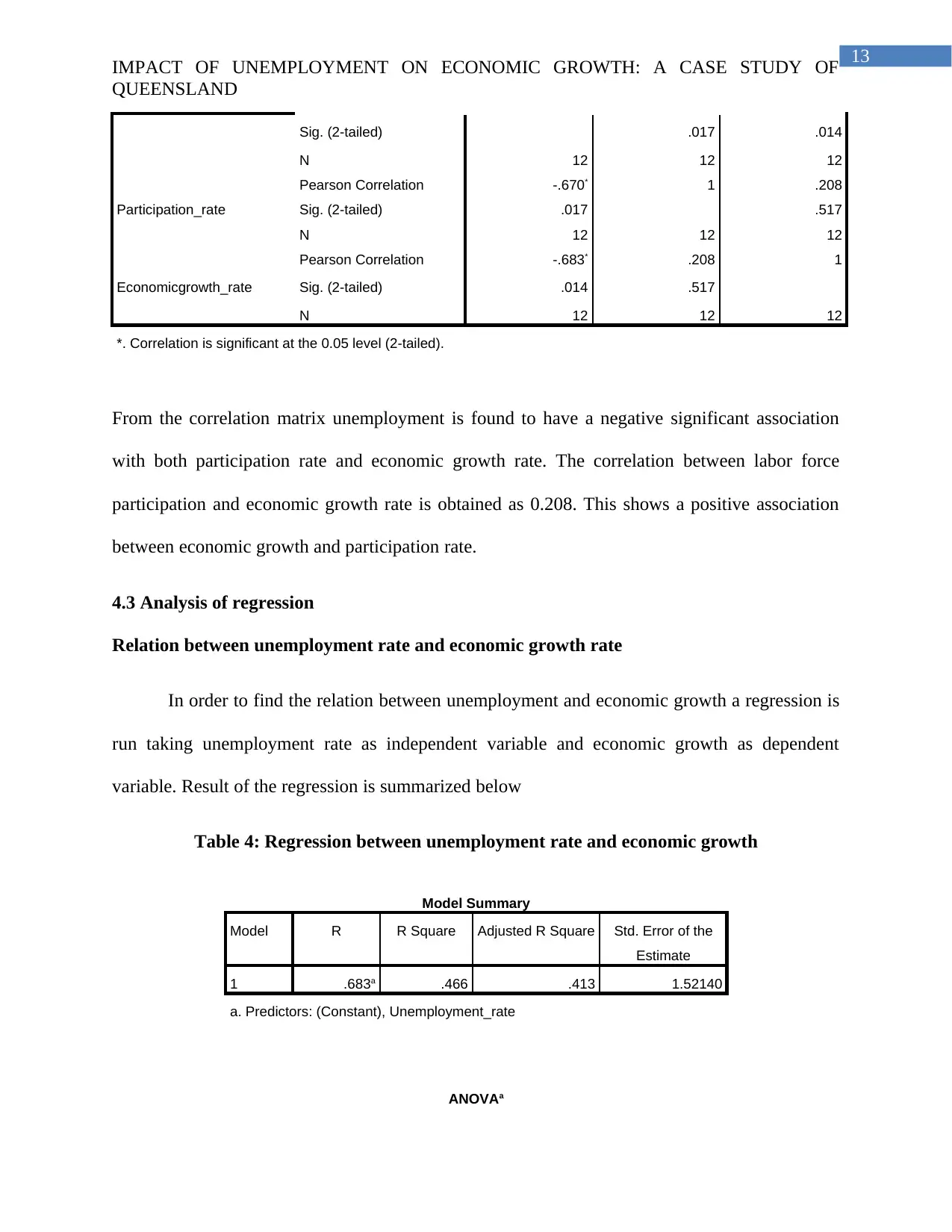
13
IMPACT OF UNEMPLOYMENT ON ECONOMIC GROWTH: A CASE STUDY OF
QUEENSLAND
Sig. (2-tailed) .017 .014
N 12 12 12
Participation_rate
Pearson Correlation -.670* 1 .208
Sig. (2-tailed) .017 .517
N 12 12 12
Economicgrowth_rate
Pearson Correlation -.683* .208 1
Sig. (2-tailed) .014 .517
N 12 12 12
*. Correlation is significant at the 0.05 level (2-tailed).
From the correlation matrix unemployment is found to have a negative significant association
with both participation rate and economic growth rate. The correlation between labor force
participation and economic growth rate is obtained as 0.208. This shows a positive association
between economic growth and participation rate.
4.3 Analysis of regression
Relation between unemployment rate and economic growth rate
In order to find the relation between unemployment and economic growth a regression is
run taking unemployment rate as independent variable and economic growth as dependent
variable. Result of the regression is summarized below
Table 4: Regression between unemployment rate and economic growth
Model Summary
Model R R Square Adjusted R Square Std. Error of the
Estimate
1 .683a .466 .413 1.52140
a. Predictors: (Constant), Unemployment_rate
ANOVAa
IMPACT OF UNEMPLOYMENT ON ECONOMIC GROWTH: A CASE STUDY OF
QUEENSLAND
Sig. (2-tailed) .017 .014
N 12 12 12
Participation_rate
Pearson Correlation -.670* 1 .208
Sig. (2-tailed) .017 .517
N 12 12 12
Economicgrowth_rate
Pearson Correlation -.683* .208 1
Sig. (2-tailed) .014 .517
N 12 12 12
*. Correlation is significant at the 0.05 level (2-tailed).
From the correlation matrix unemployment is found to have a negative significant association
with both participation rate and economic growth rate. The correlation between labor force
participation and economic growth rate is obtained as 0.208. This shows a positive association
between economic growth and participation rate.
4.3 Analysis of regression
Relation between unemployment rate and economic growth rate
In order to find the relation between unemployment and economic growth a regression is
run taking unemployment rate as independent variable and economic growth as dependent
variable. Result of the regression is summarized below
Table 4: Regression between unemployment rate and economic growth
Model Summary
Model R R Square Adjusted R Square Std. Error of the
Estimate
1 .683a .466 .413 1.52140
a. Predictors: (Constant), Unemployment_rate
ANOVAa
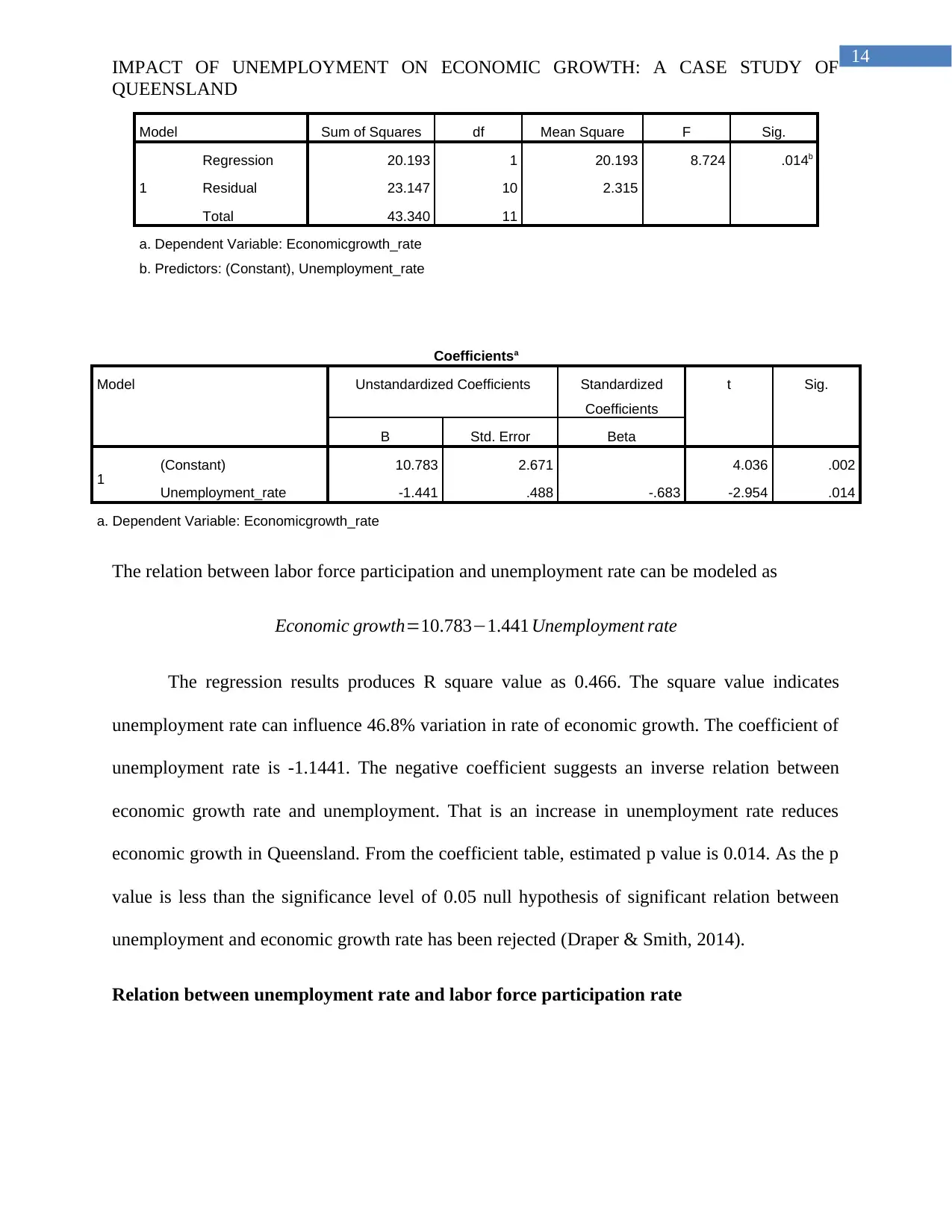
14
IMPACT OF UNEMPLOYMENT ON ECONOMIC GROWTH: A CASE STUDY OF
QUEENSLAND
Model Sum of Squares df Mean Square F Sig.
1
Regression 20.193 1 20.193 8.724 .014b
Residual 23.147 10 2.315
Total 43.340 11
a. Dependent Variable: Economicgrowth_rate
b. Predictors: (Constant), Unemployment_rate
Coefficientsa
Model Unstandardized Coefficients Standardized
Coefficients
t Sig.
B Std. Error Beta
1 (Constant) 10.783 2.671 4.036 .002
Unemployment_rate -1.441 .488 -.683 -2.954 .014
a. Dependent Variable: Economicgrowth_rate
The relation between labor force participation and unemployment rate can be modeled as
Economic growth=10.783−1.441 Unemployment rate
The regression results produces R square value as 0.466. The square value indicates
unemployment rate can influence 46.8% variation in rate of economic growth. The coefficient of
unemployment rate is -1.1441. The negative coefficient suggests an inverse relation between
economic growth rate and unemployment. That is an increase in unemployment rate reduces
economic growth in Queensland. From the coefficient table, estimated p value is 0.014. As the p
value is less than the significance level of 0.05 null hypothesis of significant relation between
unemployment and economic growth rate has been rejected (Draper & Smith, 2014).
Relation between unemployment rate and labor force participation rate
IMPACT OF UNEMPLOYMENT ON ECONOMIC GROWTH: A CASE STUDY OF
QUEENSLAND
Model Sum of Squares df Mean Square F Sig.
1
Regression 20.193 1 20.193 8.724 .014b
Residual 23.147 10 2.315
Total 43.340 11
a. Dependent Variable: Economicgrowth_rate
b. Predictors: (Constant), Unemployment_rate
Coefficientsa
Model Unstandardized Coefficients Standardized
Coefficients
t Sig.
B Std. Error Beta
1 (Constant) 10.783 2.671 4.036 .002
Unemployment_rate -1.441 .488 -.683 -2.954 .014
a. Dependent Variable: Economicgrowth_rate
The relation between labor force participation and unemployment rate can be modeled as
Economic growth=10.783−1.441 Unemployment rate
The regression results produces R square value as 0.466. The square value indicates
unemployment rate can influence 46.8% variation in rate of economic growth. The coefficient of
unemployment rate is -1.1441. The negative coefficient suggests an inverse relation between
economic growth rate and unemployment. That is an increase in unemployment rate reduces
economic growth in Queensland. From the coefficient table, estimated p value is 0.014. As the p
value is less than the significance level of 0.05 null hypothesis of significant relation between
unemployment and economic growth rate has been rejected (Draper & Smith, 2014).
Relation between unemployment rate and labor force participation rate
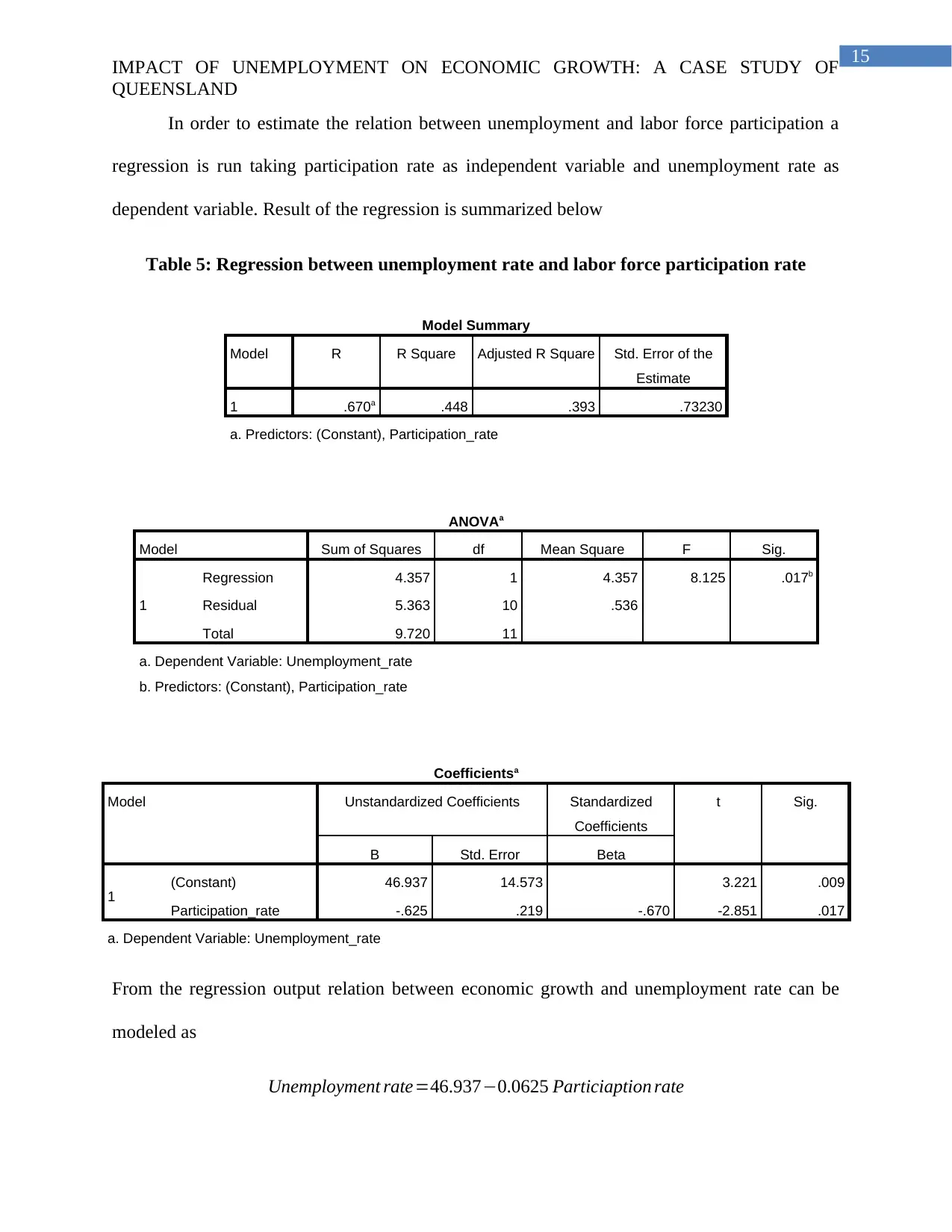
15
IMPACT OF UNEMPLOYMENT ON ECONOMIC GROWTH: A CASE STUDY OF
QUEENSLAND
In order to estimate the relation between unemployment and labor force participation a
regression is run taking participation rate as independent variable and unemployment rate as
dependent variable. Result of the regression is summarized below
Table 5: Regression between unemployment rate and labor force participation rate
Model Summary
Model R R Square Adjusted R Square Std. Error of the
Estimate
1 .670a .448 .393 .73230
a. Predictors: (Constant), Participation_rate
ANOVAa
Model Sum of Squares df Mean Square F Sig.
1
Regression 4.357 1 4.357 8.125 .017b
Residual 5.363 10 .536
Total 9.720 11
a. Dependent Variable: Unemployment_rate
b. Predictors: (Constant), Participation_rate
Coefficientsa
Model Unstandardized Coefficients Standardized
Coefficients
t Sig.
B Std. Error Beta
1 (Constant) 46.937 14.573 3.221 .009
Participation_rate -.625 .219 -.670 -2.851 .017
a. Dependent Variable: Unemployment_rate
From the regression output relation between economic growth and unemployment rate can be
modeled as
Unemployment rate=46.937−0.0625 Particiaption rate
IMPACT OF UNEMPLOYMENT ON ECONOMIC GROWTH: A CASE STUDY OF
QUEENSLAND
In order to estimate the relation between unemployment and labor force participation a
regression is run taking participation rate as independent variable and unemployment rate as
dependent variable. Result of the regression is summarized below
Table 5: Regression between unemployment rate and labor force participation rate
Model Summary
Model R R Square Adjusted R Square Std. Error of the
Estimate
1 .670a .448 .393 .73230
a. Predictors: (Constant), Participation_rate
ANOVAa
Model Sum of Squares df Mean Square F Sig.
1
Regression 4.357 1 4.357 8.125 .017b
Residual 5.363 10 .536
Total 9.720 11
a. Dependent Variable: Unemployment_rate
b. Predictors: (Constant), Participation_rate
Coefficientsa
Model Unstandardized Coefficients Standardized
Coefficients
t Sig.
B Std. Error Beta
1 (Constant) 46.937 14.573 3.221 .009
Participation_rate -.625 .219 -.670 -2.851 .017
a. Dependent Variable: Unemployment_rate
From the regression output relation between economic growth and unemployment rate can be
modeled as
Unemployment rate=46.937−0.0625 Particiaption rate
Secure Best Marks with AI Grader
Need help grading? Try our AI Grader for instant feedback on your assignments.
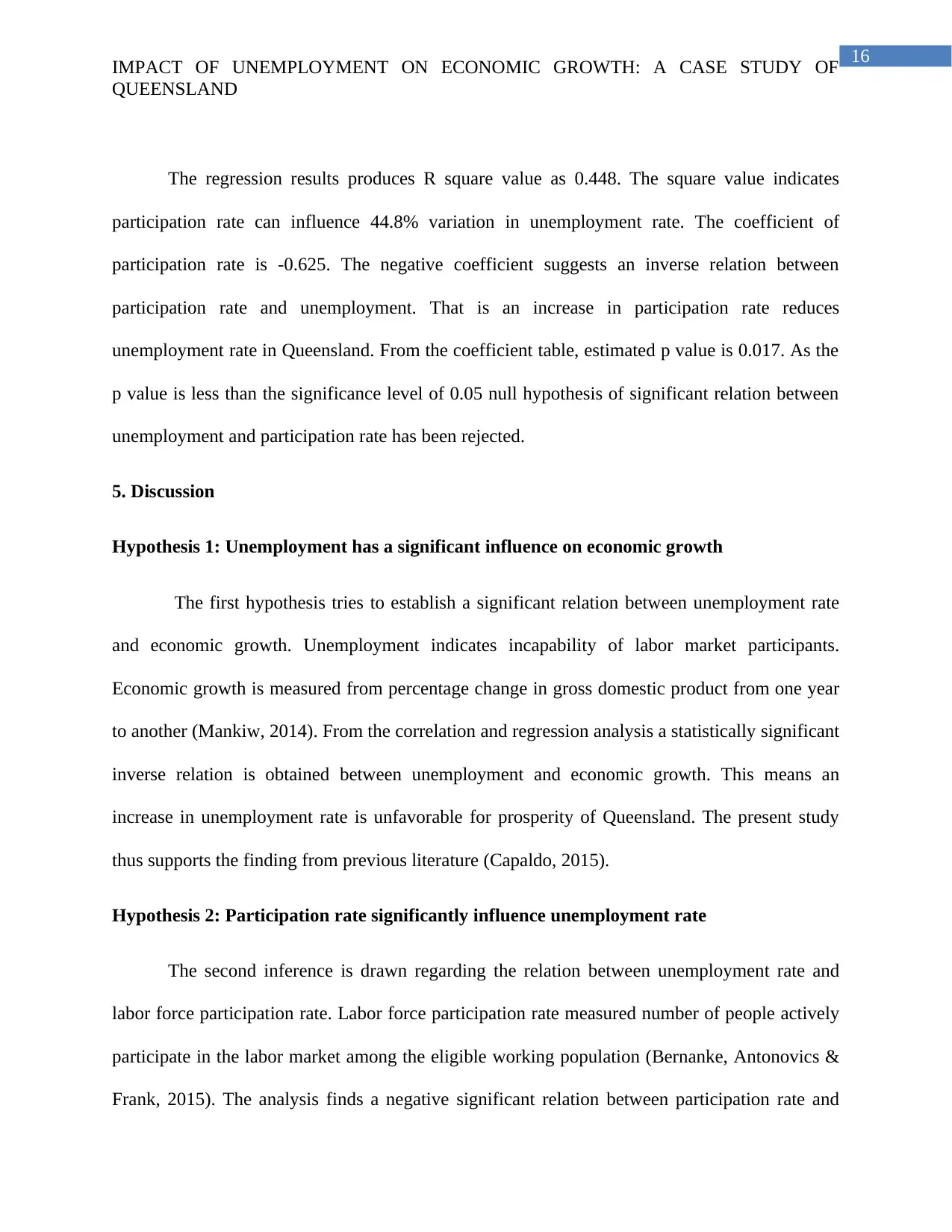
16
IMPACT OF UNEMPLOYMENT ON ECONOMIC GROWTH: A CASE STUDY OF
QUEENSLAND
The regression results produces R square value as 0.448. The square value indicates
participation rate can influence 44.8% variation in unemployment rate. The coefficient of
participation rate is -0.625. The negative coefficient suggests an inverse relation between
participation rate and unemployment. That is an increase in participation rate reduces
unemployment rate in Queensland. From the coefficient table, estimated p value is 0.017. As the
p value is less than the significance level of 0.05 null hypothesis of significant relation between
unemployment and participation rate has been rejected.
5. Discussion
Hypothesis 1: Unemployment has a significant influence on economic growth
The first hypothesis tries to establish a significant relation between unemployment rate
and economic growth. Unemployment indicates incapability of labor market participants.
Economic growth is measured from percentage change in gross domestic product from one year
to another (Mankiw, 2014). From the correlation and regression analysis a statistically significant
inverse relation is obtained between unemployment and economic growth. This means an
increase in unemployment rate is unfavorable for prosperity of Queensland. The present study
thus supports the finding from previous literature (Capaldo, 2015).
Hypothesis 2: Participation rate significantly influence unemployment rate
The second inference is drawn regarding the relation between unemployment rate and
labor force participation rate. Labor force participation rate measured number of people actively
participate in the labor market among the eligible working population (Bernanke, Antonovics &
Frank, 2015). The analysis finds a negative significant relation between participation rate and
IMPACT OF UNEMPLOYMENT ON ECONOMIC GROWTH: A CASE STUDY OF
QUEENSLAND
The regression results produces R square value as 0.448. The square value indicates
participation rate can influence 44.8% variation in unemployment rate. The coefficient of
participation rate is -0.625. The negative coefficient suggests an inverse relation between
participation rate and unemployment. That is an increase in participation rate reduces
unemployment rate in Queensland. From the coefficient table, estimated p value is 0.017. As the
p value is less than the significance level of 0.05 null hypothesis of significant relation between
unemployment and participation rate has been rejected.
5. Discussion
Hypothesis 1: Unemployment has a significant influence on economic growth
The first hypothesis tries to establish a significant relation between unemployment rate
and economic growth. Unemployment indicates incapability of labor market participants.
Economic growth is measured from percentage change in gross domestic product from one year
to another (Mankiw, 2014). From the correlation and regression analysis a statistically significant
inverse relation is obtained between unemployment and economic growth. This means an
increase in unemployment rate is unfavorable for prosperity of Queensland. The present study
thus supports the finding from previous literature (Capaldo, 2015).
Hypothesis 2: Participation rate significantly influence unemployment rate
The second inference is drawn regarding the relation between unemployment rate and
labor force participation rate. Labor force participation rate measured number of people actively
participate in the labor market among the eligible working population (Bernanke, Antonovics &
Frank, 2015). The analysis finds a negative significant relation between participation rate and
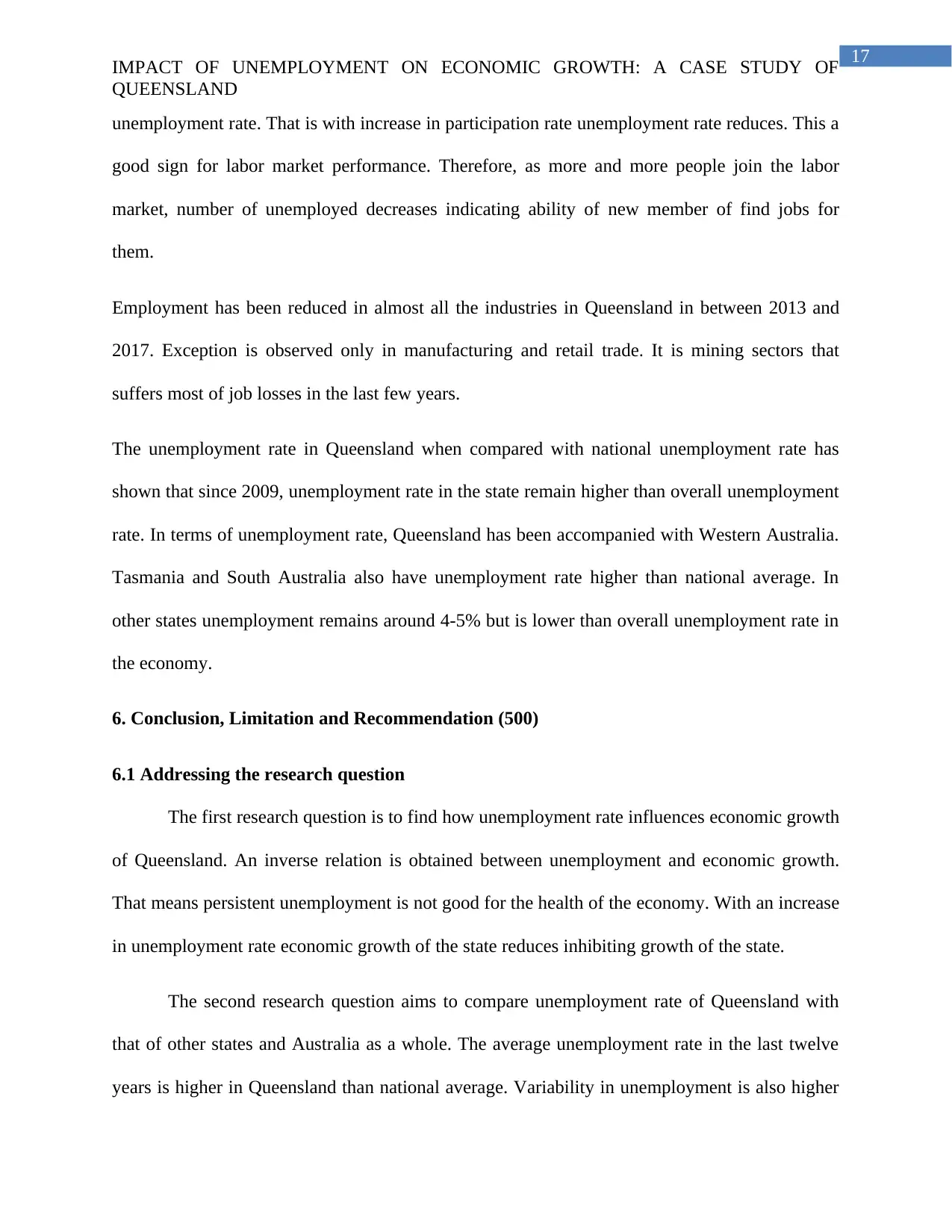
17
IMPACT OF UNEMPLOYMENT ON ECONOMIC GROWTH: A CASE STUDY OF
QUEENSLAND
unemployment rate. That is with increase in participation rate unemployment rate reduces. This a
good sign for labor market performance. Therefore, as more and more people join the labor
market, number of unemployed decreases indicating ability of new member of find jobs for
them.
Employment has been reduced in almost all the industries in Queensland in between 2013 and
2017. Exception is observed only in manufacturing and retail trade. It is mining sectors that
suffers most of job losses in the last few years.
The unemployment rate in Queensland when compared with national unemployment rate has
shown that since 2009, unemployment rate in the state remain higher than overall unemployment
rate. In terms of unemployment rate, Queensland has been accompanied with Western Australia.
Tasmania and South Australia also have unemployment rate higher than national average. In
other states unemployment remains around 4-5% but is lower than overall unemployment rate in
the economy.
6. Conclusion, Limitation and Recommendation (500)
6.1 Addressing the research question
The first research question is to find how unemployment rate influences economic growth
of Queensland. An inverse relation is obtained between unemployment and economic growth.
That means persistent unemployment is not good for the health of the economy. With an increase
in unemployment rate economic growth of the state reduces inhibiting growth of the state.
The second research question aims to compare unemployment rate of Queensland with
that of other states and Australia as a whole. The average unemployment rate in the last twelve
years is higher in Queensland than national average. Variability in unemployment is also higher
IMPACT OF UNEMPLOYMENT ON ECONOMIC GROWTH: A CASE STUDY OF
QUEENSLAND
unemployment rate. That is with increase in participation rate unemployment rate reduces. This a
good sign for labor market performance. Therefore, as more and more people join the labor
market, number of unemployed decreases indicating ability of new member of find jobs for
them.
Employment has been reduced in almost all the industries in Queensland in between 2013 and
2017. Exception is observed only in manufacturing and retail trade. It is mining sectors that
suffers most of job losses in the last few years.
The unemployment rate in Queensland when compared with national unemployment rate has
shown that since 2009, unemployment rate in the state remain higher than overall unemployment
rate. In terms of unemployment rate, Queensland has been accompanied with Western Australia.
Tasmania and South Australia also have unemployment rate higher than national average. In
other states unemployment remains around 4-5% but is lower than overall unemployment rate in
the economy.
6. Conclusion, Limitation and Recommendation (500)
6.1 Addressing the research question
The first research question is to find how unemployment rate influences economic growth
of Queensland. An inverse relation is obtained between unemployment and economic growth.
That means persistent unemployment is not good for the health of the economy. With an increase
in unemployment rate economic growth of the state reduces inhibiting growth of the state.
The second research question aims to compare unemployment rate of Queensland with
that of other states and Australia as a whole. The average unemployment rate in the last twelve
years is higher in Queensland than national average. Variability in unemployment is also higher
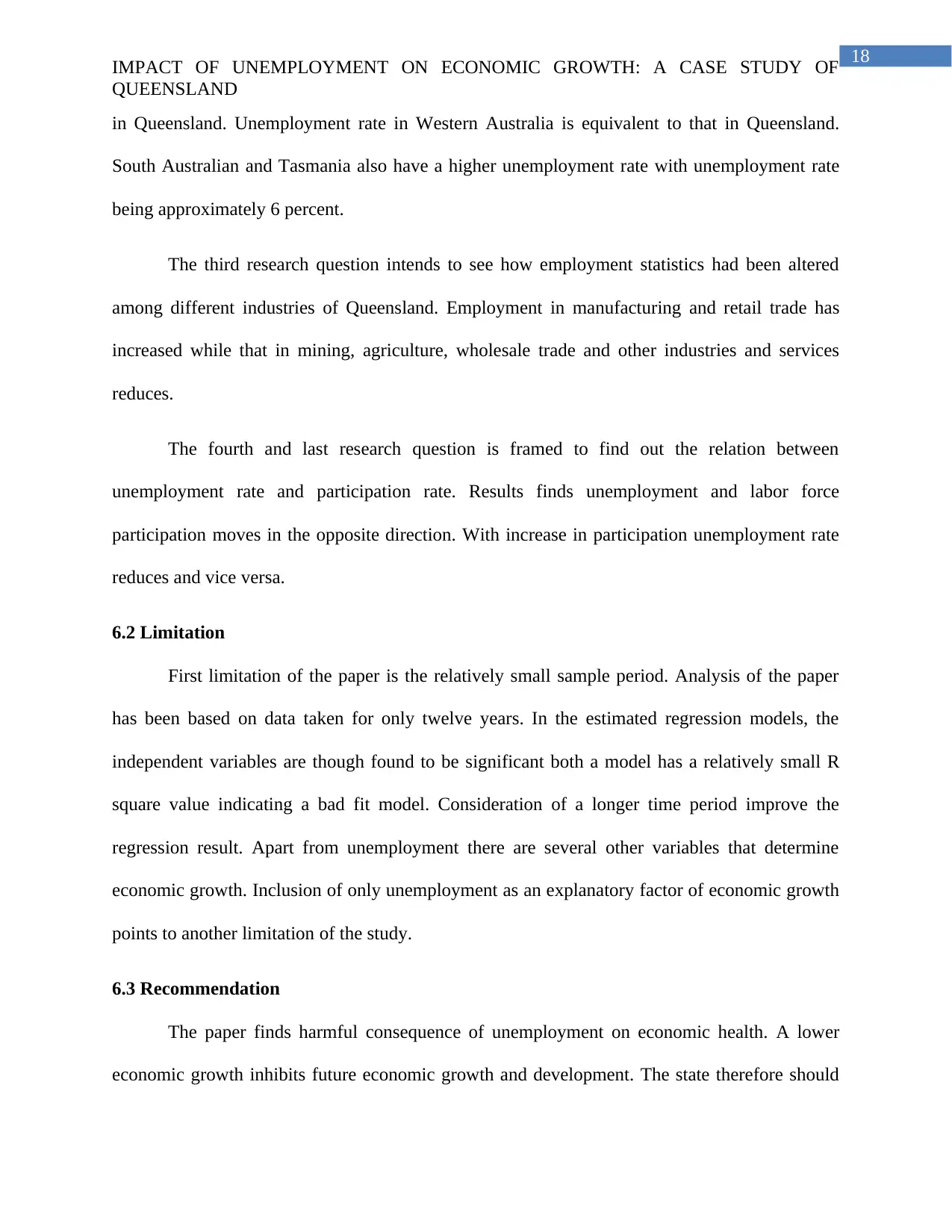
18
IMPACT OF UNEMPLOYMENT ON ECONOMIC GROWTH: A CASE STUDY OF
QUEENSLAND
in Queensland. Unemployment rate in Western Australia is equivalent to that in Queensland.
South Australian and Tasmania also have a higher unemployment rate with unemployment rate
being approximately 6 percent.
The third research question intends to see how employment statistics had been altered
among different industries of Queensland. Employment in manufacturing and retail trade has
increased while that in mining, agriculture, wholesale trade and other industries and services
reduces.
The fourth and last research question is framed to find out the relation between
unemployment rate and participation rate. Results finds unemployment and labor force
participation moves in the opposite direction. With increase in participation unemployment rate
reduces and vice versa.
6.2 Limitation
First limitation of the paper is the relatively small sample period. Analysis of the paper
has been based on data taken for only twelve years. In the estimated regression models, the
independent variables are though found to be significant both a model has a relatively small R
square value indicating a bad fit model. Consideration of a longer time period improve the
regression result. Apart from unemployment there are several other variables that determine
economic growth. Inclusion of only unemployment as an explanatory factor of economic growth
points to another limitation of the study.
6.3 Recommendation
The paper finds harmful consequence of unemployment on economic health. A lower
economic growth inhibits future economic growth and development. The state therefore should
IMPACT OF UNEMPLOYMENT ON ECONOMIC GROWTH: A CASE STUDY OF
QUEENSLAND
in Queensland. Unemployment rate in Western Australia is equivalent to that in Queensland.
South Australian and Tasmania also have a higher unemployment rate with unemployment rate
being approximately 6 percent.
The third research question intends to see how employment statistics had been altered
among different industries of Queensland. Employment in manufacturing and retail trade has
increased while that in mining, agriculture, wholesale trade and other industries and services
reduces.
The fourth and last research question is framed to find out the relation between
unemployment rate and participation rate. Results finds unemployment and labor force
participation moves in the opposite direction. With increase in participation unemployment rate
reduces and vice versa.
6.2 Limitation
First limitation of the paper is the relatively small sample period. Analysis of the paper
has been based on data taken for only twelve years. In the estimated regression models, the
independent variables are though found to be significant both a model has a relatively small R
square value indicating a bad fit model. Consideration of a longer time period improve the
regression result. Apart from unemployment there are several other variables that determine
economic growth. Inclusion of only unemployment as an explanatory factor of economic growth
points to another limitation of the study.
6.3 Recommendation
The paper finds harmful consequence of unemployment on economic health. A lower
economic growth inhibits future economic growth and development. The state therefore should
Paraphrase This Document
Need a fresh take? Get an instant paraphrase of this document with our AI Paraphraser
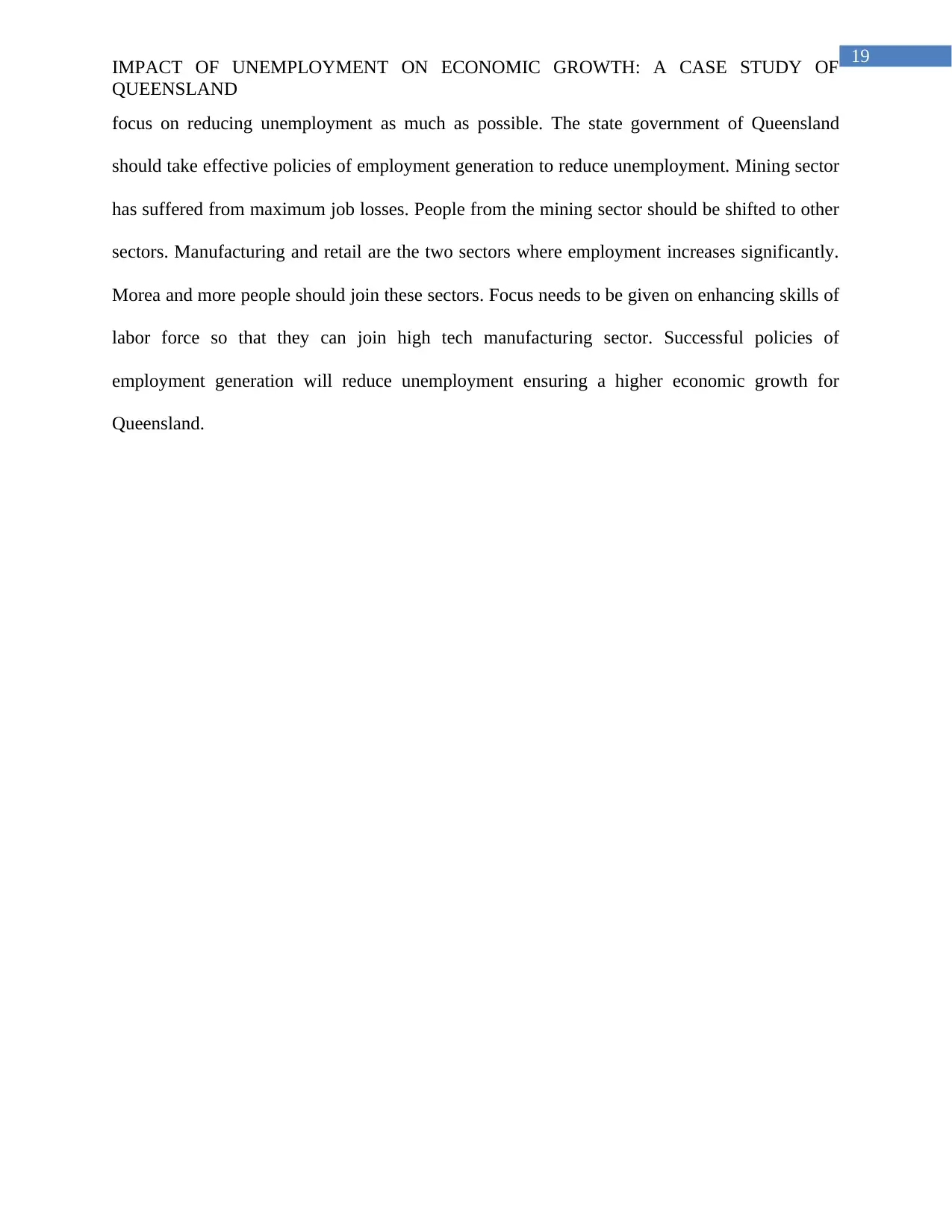
19
IMPACT OF UNEMPLOYMENT ON ECONOMIC GROWTH: A CASE STUDY OF
QUEENSLAND
focus on reducing unemployment as much as possible. The state government of Queensland
should take effective policies of employment generation to reduce unemployment. Mining sector
has suffered from maximum job losses. People from the mining sector should be shifted to other
sectors. Manufacturing and retail are the two sectors where employment increases significantly.
Morea and more people should join these sectors. Focus needs to be given on enhancing skills of
labor force so that they can join high tech manufacturing sector. Successful policies of
employment generation will reduce unemployment ensuring a higher economic growth for
Queensland.
IMPACT OF UNEMPLOYMENT ON ECONOMIC GROWTH: A CASE STUDY OF
QUEENSLAND
focus on reducing unemployment as much as possible. The state government of Queensland
should take effective policies of employment generation to reduce unemployment. Mining sector
has suffered from maximum job losses. People from the mining sector should be shifted to other
sectors. Manufacturing and retail are the two sectors where employment increases significantly.
Morea and more people should join these sectors. Focus needs to be given on enhancing skills of
labor force so that they can join high tech manufacturing sector. Successful policies of
employment generation will reduce unemployment ensuring a higher economic growth for
Queensland.
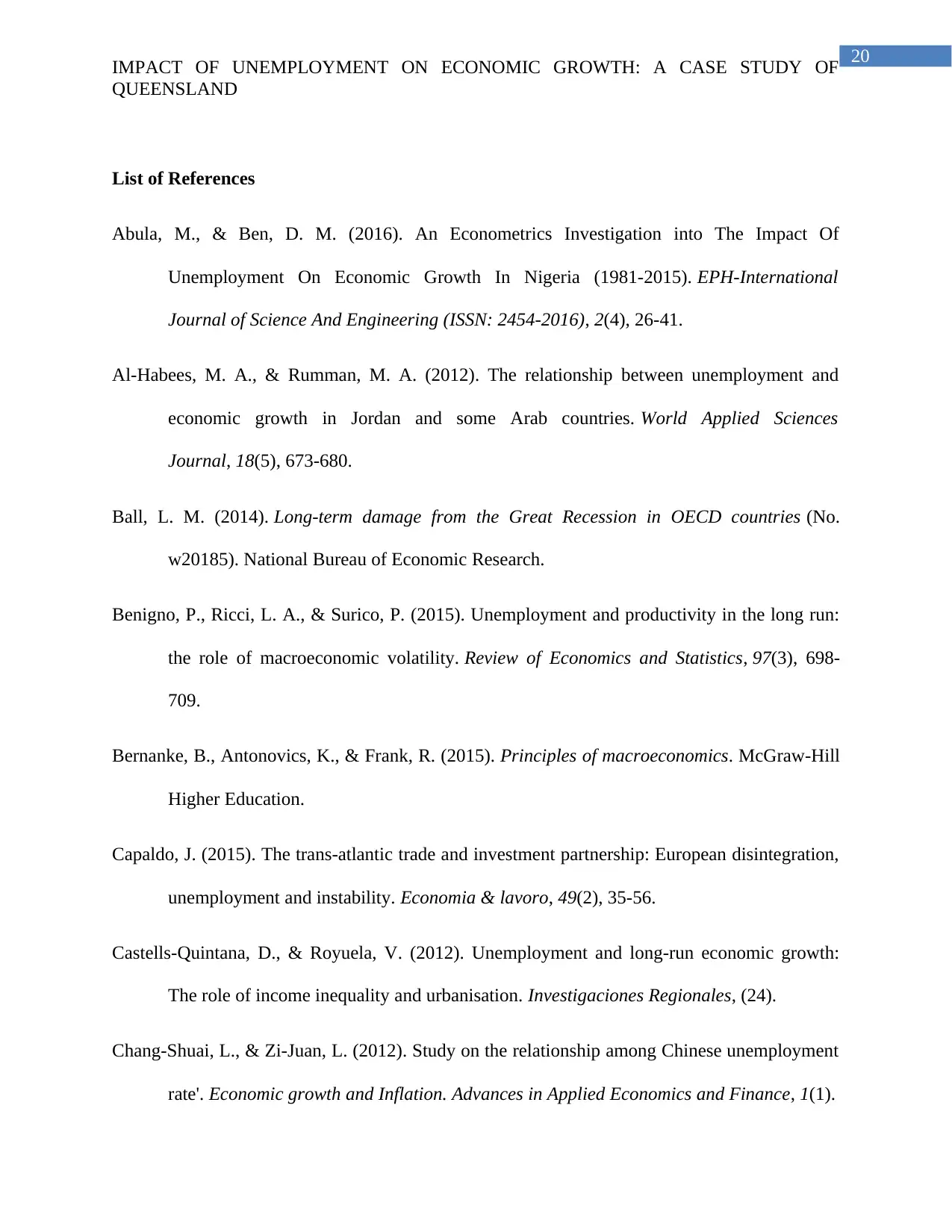
20
IMPACT OF UNEMPLOYMENT ON ECONOMIC GROWTH: A CASE STUDY OF
QUEENSLAND
List of References
Abula, M., & Ben, D. M. (2016). An Econometrics Investigation into The Impact Of
Unemployment On Economic Growth In Nigeria (1981-2015). EPH-International
Journal of Science And Engineering (ISSN: 2454-2016), 2(4), 26-41.
Al-Habees, M. A., & Rumman, M. A. (2012). The relationship between unemployment and
economic growth in Jordan and some Arab countries. World Applied Sciences
Journal, 18(5), 673-680.
Ball, L. M. (2014). Long-term damage from the Great Recession in OECD countries (No.
w20185). National Bureau of Economic Research.
Benigno, P., Ricci, L. A., & Surico, P. (2015). Unemployment and productivity in the long run:
the role of macroeconomic volatility. Review of Economics and Statistics, 97(3), 698-
709.
Bernanke, B., Antonovics, K., & Frank, R. (2015). Principles of macroeconomics. McGraw-Hill
Higher Education.
Capaldo, J. (2015). The trans-atlantic trade and investment partnership: European disintegration,
unemployment and instability. Economia & lavoro, 49(2), 35-56.
Castells-Quintana, D., & Royuela, V. (2012). Unemployment and long-run economic growth:
The role of income inequality and urbanisation. Investigaciones Regionales, (24).
Chang-Shuai, L., & Zi-Juan, L. (2012). Study on the relationship among Chinese unemployment
rate'. Economic growth and Inflation. Advances in Applied Economics and Finance, 1(1).
IMPACT OF UNEMPLOYMENT ON ECONOMIC GROWTH: A CASE STUDY OF
QUEENSLAND
List of References
Abula, M., & Ben, D. M. (2016). An Econometrics Investigation into The Impact Of
Unemployment On Economic Growth In Nigeria (1981-2015). EPH-International
Journal of Science And Engineering (ISSN: 2454-2016), 2(4), 26-41.
Al-Habees, M. A., & Rumman, M. A. (2012). The relationship between unemployment and
economic growth in Jordan and some Arab countries. World Applied Sciences
Journal, 18(5), 673-680.
Ball, L. M. (2014). Long-term damage from the Great Recession in OECD countries (No.
w20185). National Bureau of Economic Research.
Benigno, P., Ricci, L. A., & Surico, P. (2015). Unemployment and productivity in the long run:
the role of macroeconomic volatility. Review of Economics and Statistics, 97(3), 698-
709.
Bernanke, B., Antonovics, K., & Frank, R. (2015). Principles of macroeconomics. McGraw-Hill
Higher Education.
Capaldo, J. (2015). The trans-atlantic trade and investment partnership: European disintegration,
unemployment and instability. Economia & lavoro, 49(2), 35-56.
Castells-Quintana, D., & Royuela, V. (2012). Unemployment and long-run economic growth:
The role of income inequality and urbanisation. Investigaciones Regionales, (24).
Chang-Shuai, L., & Zi-Juan, L. (2012). Study on the relationship among Chinese unemployment
rate'. Economic growth and Inflation. Advances in Applied Economics and Finance, 1(1).
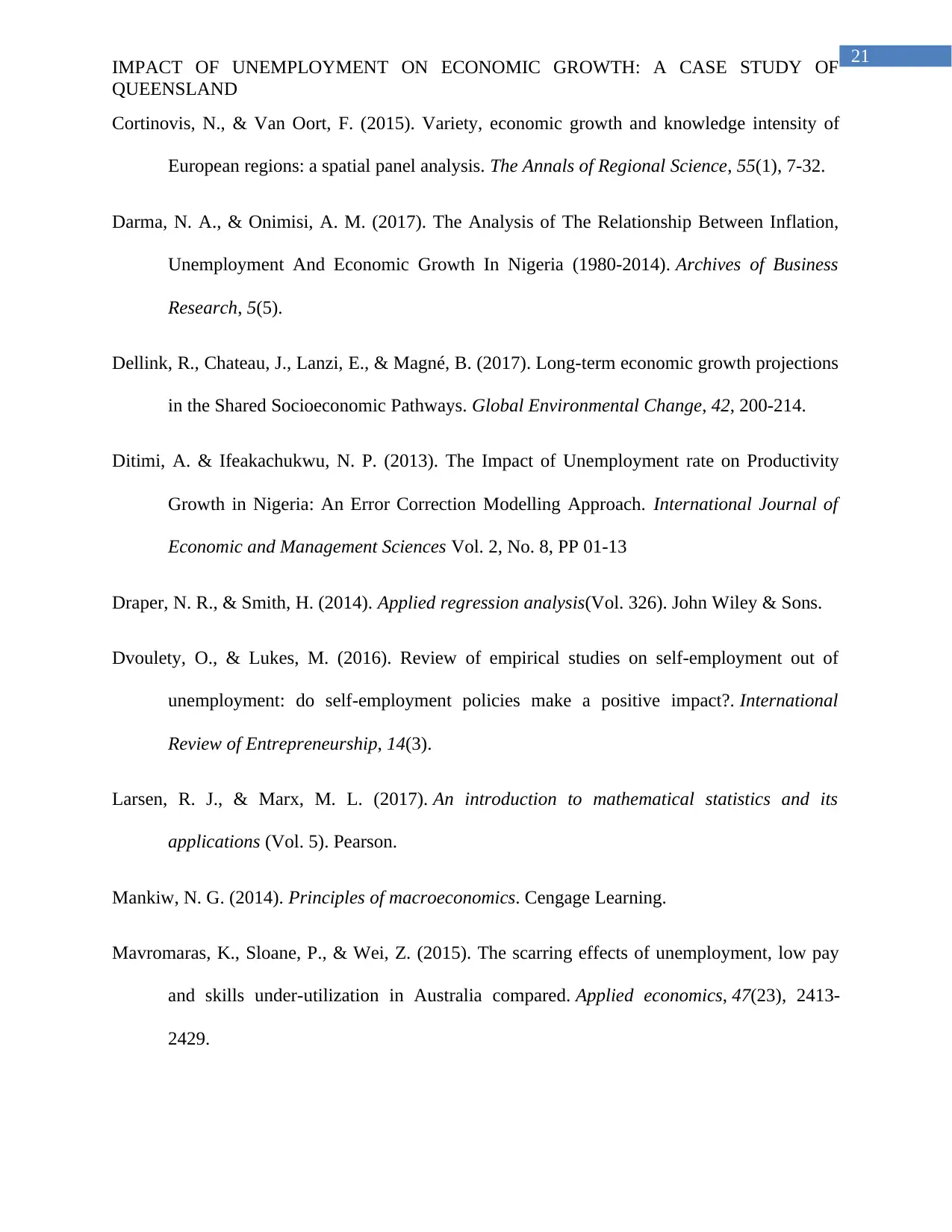
21
IMPACT OF UNEMPLOYMENT ON ECONOMIC GROWTH: A CASE STUDY OF
QUEENSLAND
Cortinovis, N., & Van Oort, F. (2015). Variety, economic growth and knowledge intensity of
European regions: a spatial panel analysis. The Annals of Regional Science, 55(1), 7-32.
Darma, N. A., & Onimisi, A. M. (2017). The Analysis of The Relationship Between Inflation,
Unemployment And Economic Growth In Nigeria (1980-2014). Archives of Business
Research, 5(5).
Dellink, R., Chateau, J., Lanzi, E., & Magné, B. (2017). Long-term economic growth projections
in the Shared Socioeconomic Pathways. Global Environmental Change, 42, 200-214.
Ditimi, A. & Ifeakachukwu, N. P. (2013). The Impact of Unemployment rate on Productivity
Growth in Nigeria: An Error Correction Modelling Approach. International Journal of
Economic and Management Sciences Vol. 2, No. 8, PP 01-13
Draper, N. R., & Smith, H. (2014). Applied regression analysis(Vol. 326). John Wiley & Sons.
Dvoulety, O., & Lukes, M. (2016). Review of empirical studies on self-employment out of
unemployment: do self-employment policies make a positive impact?. International
Review of Entrepreneurship, 14(3).
Larsen, R. J., & Marx, M. L. (2017). An introduction to mathematical statistics and its
applications (Vol. 5). Pearson.
Mankiw, N. G. (2014). Principles of macroeconomics. Cengage Learning.
Mavromaras, K., Sloane, P., & Wei, Z. (2015). The scarring effects of unemployment, low pay
and skills under-utilization in Australia compared. Applied economics, 47(23), 2413-
2429.
IMPACT OF UNEMPLOYMENT ON ECONOMIC GROWTH: A CASE STUDY OF
QUEENSLAND
Cortinovis, N., & Van Oort, F. (2015). Variety, economic growth and knowledge intensity of
European regions: a spatial panel analysis. The Annals of Regional Science, 55(1), 7-32.
Darma, N. A., & Onimisi, A. M. (2017). The Analysis of The Relationship Between Inflation,
Unemployment And Economic Growth In Nigeria (1980-2014). Archives of Business
Research, 5(5).
Dellink, R., Chateau, J., Lanzi, E., & Magné, B. (2017). Long-term economic growth projections
in the Shared Socioeconomic Pathways. Global Environmental Change, 42, 200-214.
Ditimi, A. & Ifeakachukwu, N. P. (2013). The Impact of Unemployment rate on Productivity
Growth in Nigeria: An Error Correction Modelling Approach. International Journal of
Economic and Management Sciences Vol. 2, No. 8, PP 01-13
Draper, N. R., & Smith, H. (2014). Applied regression analysis(Vol. 326). John Wiley & Sons.
Dvoulety, O., & Lukes, M. (2016). Review of empirical studies on self-employment out of
unemployment: do self-employment policies make a positive impact?. International
Review of Entrepreneurship, 14(3).
Larsen, R. J., & Marx, M. L. (2017). An introduction to mathematical statistics and its
applications (Vol. 5). Pearson.
Mankiw, N. G. (2014). Principles of macroeconomics. Cengage Learning.
Mavromaras, K., Sloane, P., & Wei, Z. (2015). The scarring effects of unemployment, low pay
and skills under-utilization in Australia compared. Applied economics, 47(23), 2413-
2429.
Secure Best Marks with AI Grader
Need help grading? Try our AI Grader for instant feedback on your assignments.
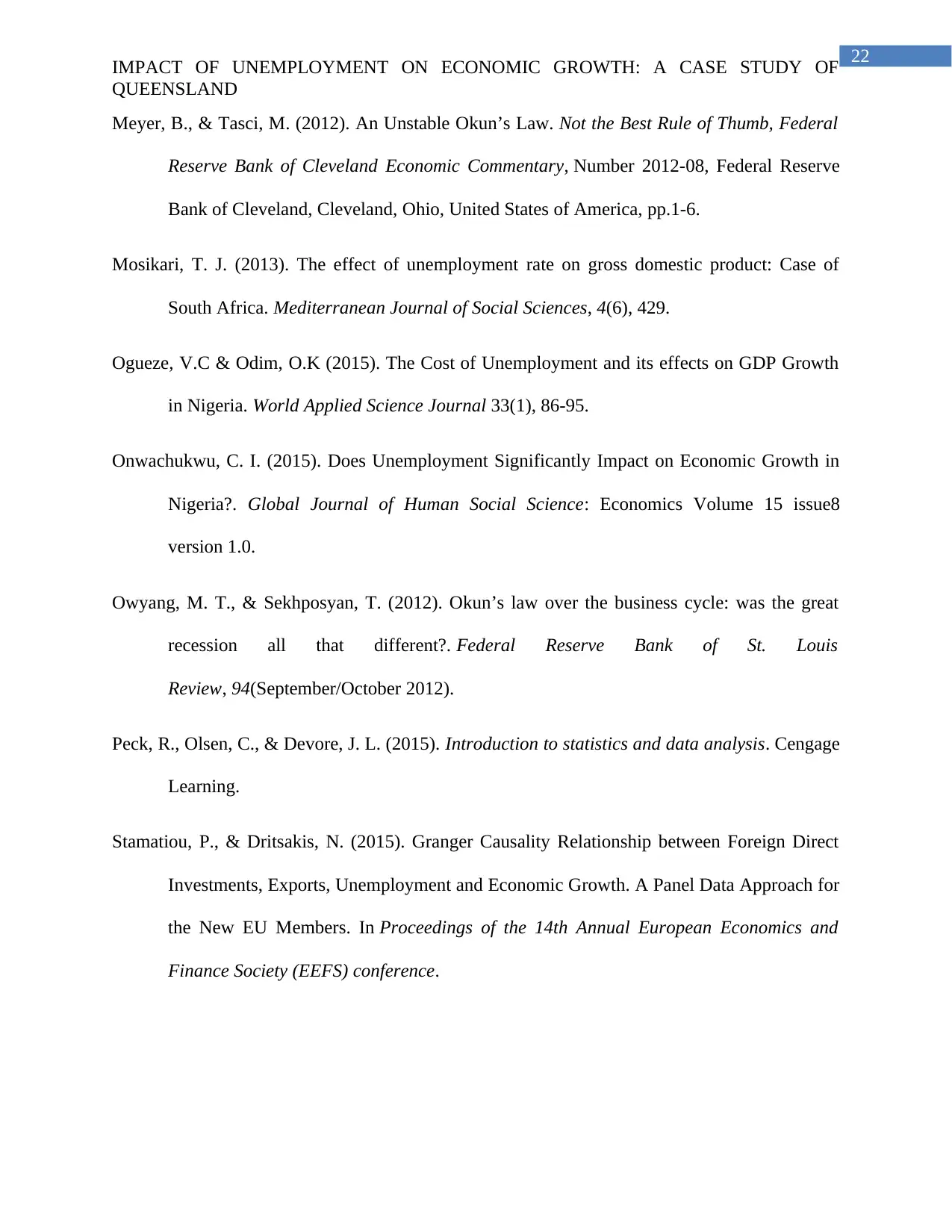
22
IMPACT OF UNEMPLOYMENT ON ECONOMIC GROWTH: A CASE STUDY OF
QUEENSLAND
Meyer, B., & Tasci, M. (2012). An Unstable Okun’s Law. Not the Best Rule of Thumb, Federal
Reserve Bank of Cleveland Economic Commentary, Number 2012-08, Federal Reserve
Bank of Cleveland, Cleveland, Ohio, United States of America, pp.1-6.
Mosikari, T. J. (2013). The effect of unemployment rate on gross domestic product: Case of
South Africa. Mediterranean Journal of Social Sciences, 4(6), 429.
Ogueze, V.C & Odim, O.K (2015). The Cost of Unemployment and its effects on GDP Growth
in Nigeria. World Applied Science Journal 33(1), 86-95.
Onwachukwu, C. I. (2015). Does Unemployment Significantly Impact on Economic Growth in
Nigeria?. Global Journal of Human Social Science: Economics Volume 15 issue8
version 1.0.
Owyang, M. T., & Sekhposyan, T. (2012). Okun’s law over the business cycle: was the great
recession all that different?. Federal Reserve Bank of St. Louis
Review, 94(September/October 2012).
Peck, R., Olsen, C., & Devore, J. L. (2015). Introduction to statistics and data analysis. Cengage
Learning.
Stamatiou, P., & Dritsakis, N. (2015). Granger Causality Relationship between Foreign Direct
Investments, Exports, Unemployment and Economic Growth. A Panel Data Approach for
the New EU Members. In Proceedings of the 14th Annual European Economics and
Finance Society (EEFS) conference.
IMPACT OF UNEMPLOYMENT ON ECONOMIC GROWTH: A CASE STUDY OF
QUEENSLAND
Meyer, B., & Tasci, M. (2012). An Unstable Okun’s Law. Not the Best Rule of Thumb, Federal
Reserve Bank of Cleveland Economic Commentary, Number 2012-08, Federal Reserve
Bank of Cleveland, Cleveland, Ohio, United States of America, pp.1-6.
Mosikari, T. J. (2013). The effect of unemployment rate on gross domestic product: Case of
South Africa. Mediterranean Journal of Social Sciences, 4(6), 429.
Ogueze, V.C & Odim, O.K (2015). The Cost of Unemployment and its effects on GDP Growth
in Nigeria. World Applied Science Journal 33(1), 86-95.
Onwachukwu, C. I. (2015). Does Unemployment Significantly Impact on Economic Growth in
Nigeria?. Global Journal of Human Social Science: Economics Volume 15 issue8
version 1.0.
Owyang, M. T., & Sekhposyan, T. (2012). Okun’s law over the business cycle: was the great
recession all that different?. Federal Reserve Bank of St. Louis
Review, 94(September/October 2012).
Peck, R., Olsen, C., & Devore, J. L. (2015). Introduction to statistics and data analysis. Cengage
Learning.
Stamatiou, P., & Dritsakis, N. (2015). Granger Causality Relationship between Foreign Direct
Investments, Exports, Unemployment and Economic Growth. A Panel Data Approach for
the New EU Members. In Proceedings of the 14th Annual European Economics and
Finance Society (EEFS) conference.
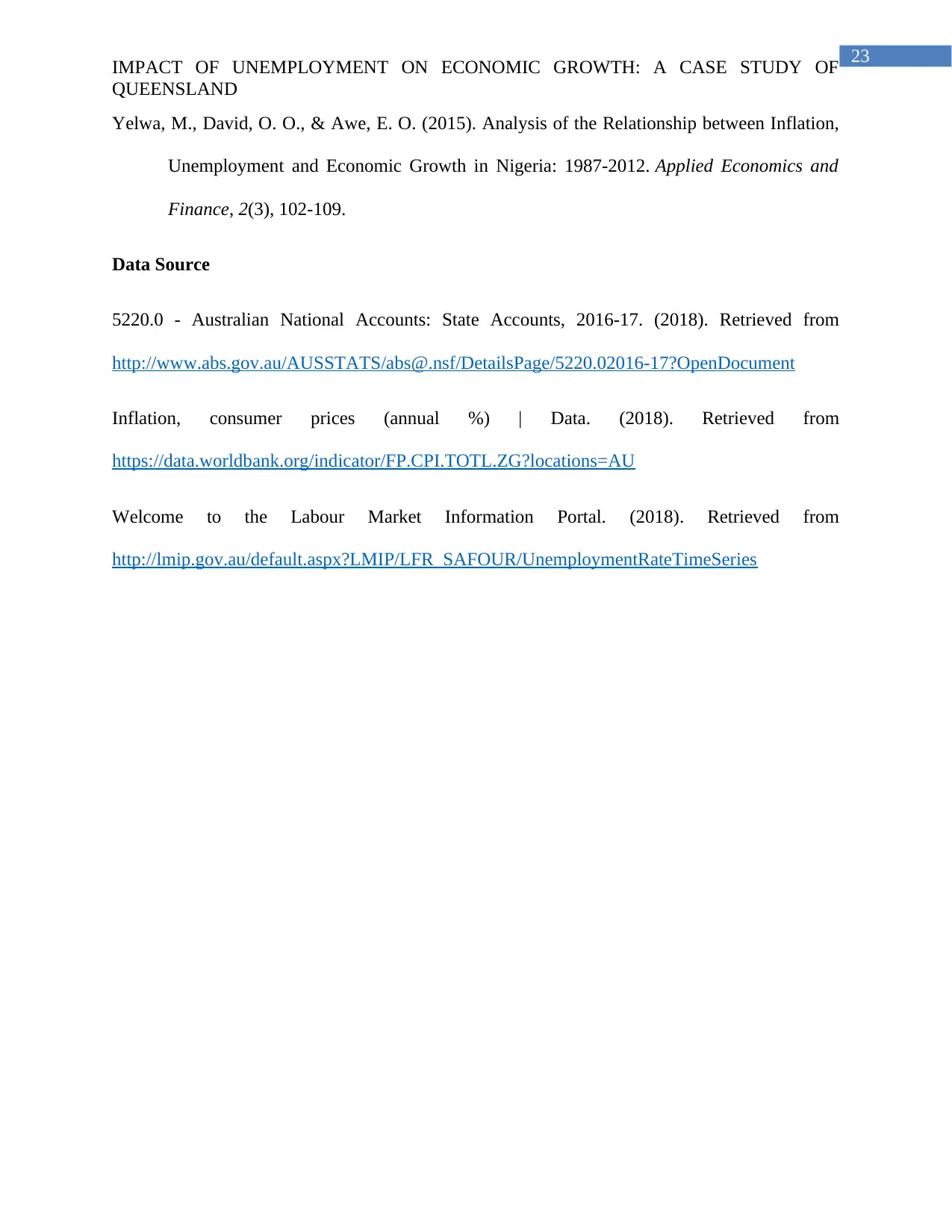
23
IMPACT OF UNEMPLOYMENT ON ECONOMIC GROWTH: A CASE STUDY OF
QUEENSLAND
Yelwa, M., David, O. O., & Awe, E. O. (2015). Analysis of the Relationship between Inflation,
Unemployment and Economic Growth in Nigeria: 1987-2012. Applied Economics and
Finance, 2(3), 102-109.
Data Source
5220.0 - Australian National Accounts: State Accounts, 2016-17. (2018). Retrieved from
http://www.abs.gov.au/AUSSTATS/abs@.nsf/DetailsPage/5220.02016-17?OpenDocument
Inflation, consumer prices (annual %) | Data. (2018). Retrieved from
https://data.worldbank.org/indicator/FP.CPI.TOTL.ZG?locations=AU
Welcome to the Labour Market Information Portal. (2018). Retrieved from
http://lmip.gov.au/default.aspx?LMIP/LFR_SAFOUR/UnemploymentRateTimeSeries
IMPACT OF UNEMPLOYMENT ON ECONOMIC GROWTH: A CASE STUDY OF
QUEENSLAND
Yelwa, M., David, O. O., & Awe, E. O. (2015). Analysis of the Relationship between Inflation,
Unemployment and Economic Growth in Nigeria: 1987-2012. Applied Economics and
Finance, 2(3), 102-109.
Data Source
5220.0 - Australian National Accounts: State Accounts, 2016-17. (2018). Retrieved from
http://www.abs.gov.au/AUSSTATS/abs@.nsf/DetailsPage/5220.02016-17?OpenDocument
Inflation, consumer prices (annual %) | Data. (2018). Retrieved from
https://data.worldbank.org/indicator/FP.CPI.TOTL.ZG?locations=AU
Welcome to the Labour Market Information Portal. (2018). Retrieved from
http://lmip.gov.au/default.aspx?LMIP/LFR_SAFOUR/UnemploymentRateTimeSeries
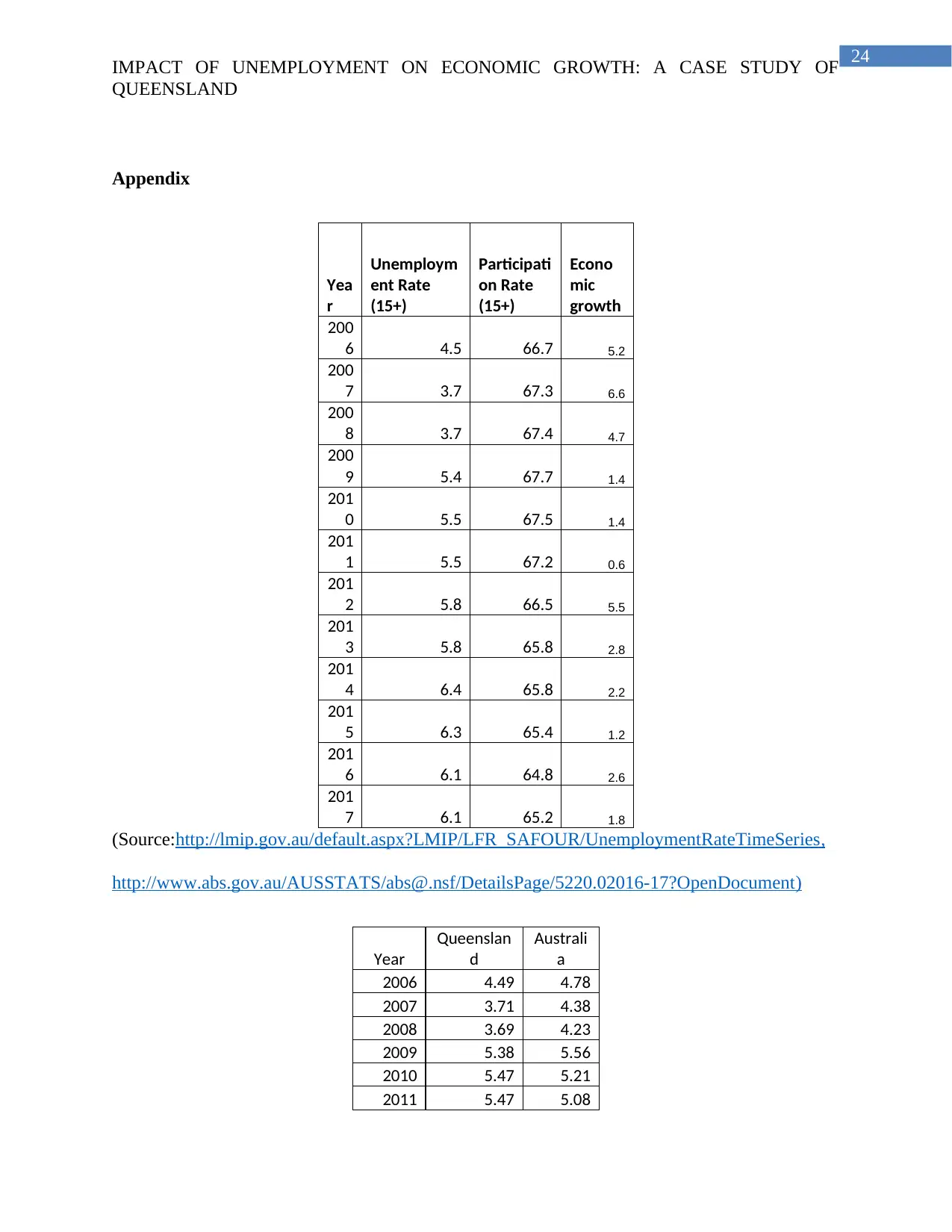
24
IMPACT OF UNEMPLOYMENT ON ECONOMIC GROWTH: A CASE STUDY OF
QUEENSLAND
Appendix
Yea
r
Unemploym
ent Rate
(15+)
Participati
on Rate
(15+)
Econo
mic
growth
200
6 4.5 66.7 5.2
200
7 3.7 67.3 6.6
200
8 3.7 67.4 4.7
200
9 5.4 67.7 1.4
201
0 5.5 67.5 1.4
201
1 5.5 67.2 0.6
201
2 5.8 66.5 5.5
201
3 5.8 65.8 2.8
201
4 6.4 65.8 2.2
201
5 6.3 65.4 1.2
201
6 6.1 64.8 2.6
201
7 6.1 65.2 1.8
(Source:http://lmip.gov.au/default.aspx?LMIP/LFR_SAFOUR/UnemploymentRateTimeSeries,
http://www.abs.gov.au/AUSSTATS/abs@.nsf/DetailsPage/5220.02016-17?OpenDocument)
Year
Queenslan
d
Australi
a
2006 4.49 4.78
2007 3.71 4.38
2008 3.69 4.23
2009 5.38 5.56
2010 5.47 5.21
2011 5.47 5.08
IMPACT OF UNEMPLOYMENT ON ECONOMIC GROWTH: A CASE STUDY OF
QUEENSLAND
Appendix
Yea
r
Unemploym
ent Rate
(15+)
Participati
on Rate
(15+)
Econo
mic
growth
200
6 4.5 66.7 5.2
200
7 3.7 67.3 6.6
200
8 3.7 67.4 4.7
200
9 5.4 67.7 1.4
201
0 5.5 67.5 1.4
201
1 5.5 67.2 0.6
201
2 5.8 66.5 5.5
201
3 5.8 65.8 2.8
201
4 6.4 65.8 2.2
201
5 6.3 65.4 1.2
201
6 6.1 64.8 2.6
201
7 6.1 65.2 1.8
(Source:http://lmip.gov.au/default.aspx?LMIP/LFR_SAFOUR/UnemploymentRateTimeSeries,
http://www.abs.gov.au/AUSSTATS/abs@.nsf/DetailsPage/5220.02016-17?OpenDocument)
Year
Queenslan
d
Australi
a
2006 4.49 4.78
2007 3.71 4.38
2008 3.69 4.23
2009 5.38 5.56
2010 5.47 5.21
2011 5.47 5.08
Paraphrase This Document
Need a fresh take? Get an instant paraphrase of this document with our AI Paraphraser
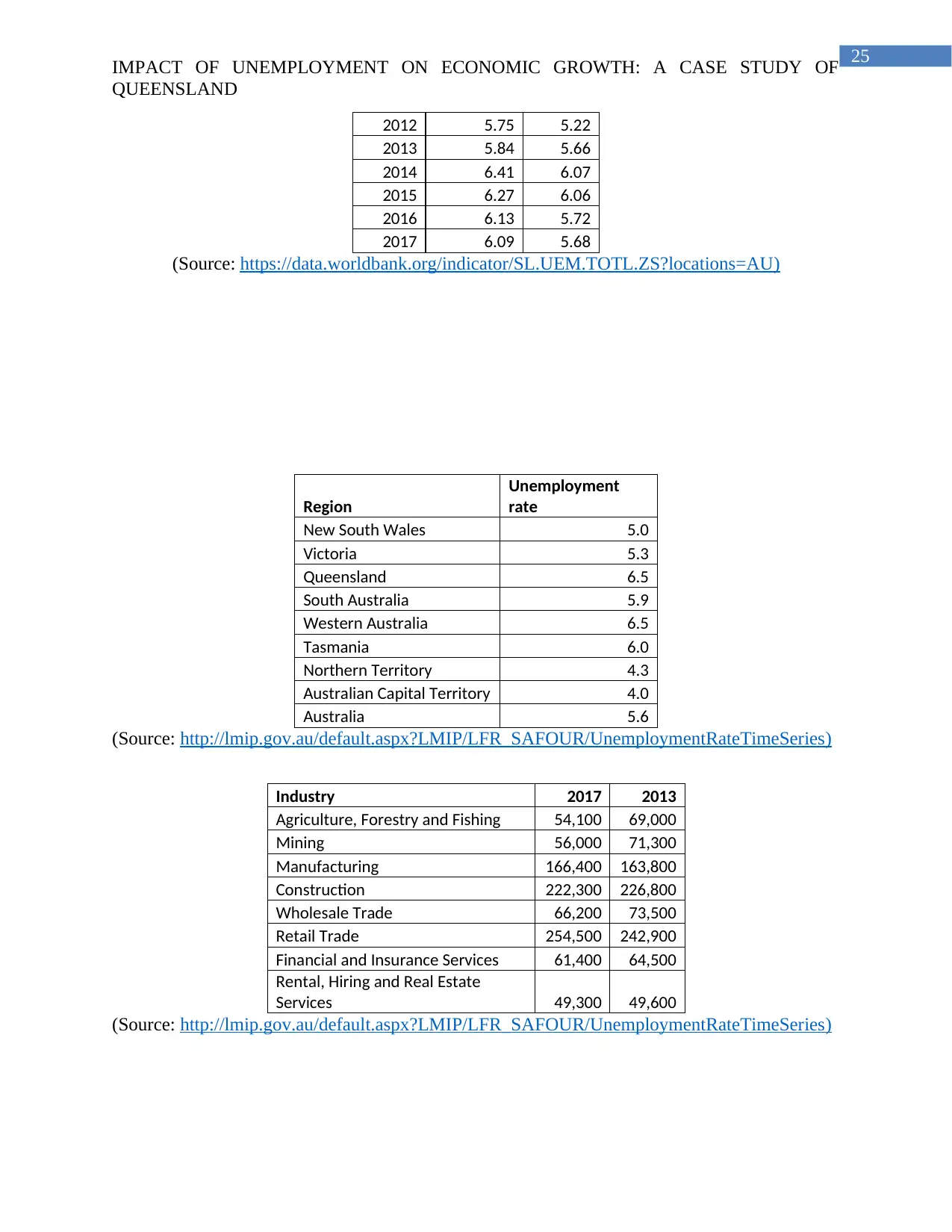
25
IMPACT OF UNEMPLOYMENT ON ECONOMIC GROWTH: A CASE STUDY OF
QUEENSLAND
2012 5.75 5.22
2013 5.84 5.66
2014 6.41 6.07
2015 6.27 6.06
2016 6.13 5.72
2017 6.09 5.68
(Source: https://data.worldbank.org/indicator/SL.UEM.TOTL.ZS?locations=AU)
Region
Unemployment
rate
New South Wales 5.0
Victoria 5.3
Queensland 6.5
South Australia 5.9
Western Australia 6.5
Tasmania 6.0
Northern Territory 4.3
Australian Capital Territory 4.0
Australia 5.6
(Source: http://lmip.gov.au/default.aspx?LMIP/LFR_SAFOUR/UnemploymentRateTimeSeries)
Industry 2017 2013
Agriculture, Forestry and Fishing 54,100 69,000
Mining 56,000 71,300
Manufacturing 166,400 163,800
Construction 222,300 226,800
Wholesale Trade 66,200 73,500
Retail Trade 254,500 242,900
Financial and Insurance Services 61,400 64,500
Rental, Hiring and Real Estate
Services 49,300 49,600
(Source: http://lmip.gov.au/default.aspx?LMIP/LFR_SAFOUR/UnemploymentRateTimeSeries)
IMPACT OF UNEMPLOYMENT ON ECONOMIC GROWTH: A CASE STUDY OF
QUEENSLAND
2012 5.75 5.22
2013 5.84 5.66
2014 6.41 6.07
2015 6.27 6.06
2016 6.13 5.72
2017 6.09 5.68
(Source: https://data.worldbank.org/indicator/SL.UEM.TOTL.ZS?locations=AU)
Region
Unemployment
rate
New South Wales 5.0
Victoria 5.3
Queensland 6.5
South Australia 5.9
Western Australia 6.5
Tasmania 6.0
Northern Territory 4.3
Australian Capital Territory 4.0
Australia 5.6
(Source: http://lmip.gov.au/default.aspx?LMIP/LFR_SAFOUR/UnemploymentRateTimeSeries)
Industry 2017 2013
Agriculture, Forestry and Fishing 54,100 69,000
Mining 56,000 71,300
Manufacturing 166,400 163,800
Construction 222,300 226,800
Wholesale Trade 66,200 73,500
Retail Trade 254,500 242,900
Financial and Insurance Services 61,400 64,500
Rental, Hiring and Real Estate
Services 49,300 49,600
(Source: http://lmip.gov.au/default.aspx?LMIP/LFR_SAFOUR/UnemploymentRateTimeSeries)

26
IMPACT OF UNEMPLOYMENT ON ECONOMIC GROWTH: A CASE STUDY OF
QUEENSLAND
IMPACT OF UNEMPLOYMENT ON ECONOMIC GROWTH: A CASE STUDY OF
QUEENSLAND
1 out of 27
Related Documents
Your All-in-One AI-Powered Toolkit for Academic Success.
+13062052269
info@desklib.com
Available 24*7 on WhatsApp / Email
![[object Object]](/_next/static/media/star-bottom.7253800d.svg)
Unlock your academic potential
© 2024 | Zucol Services PVT LTD | All rights reserved.





